This week’s inspiration is from Indian scientist and environmental activist Vandana Shiva: “You are not…
The post Earth911 Inspiration: The Planet Is Carrying You appeared first on Earth911.

This week’s inspiration is from Indian scientist and environmental activist Vandana Shiva: “You are not…
The post Earth911 Inspiration: The Planet Is Carrying You appeared first on Earth911.

As more and more Americans embrace electric vehicles, automakers and the federal government are racing to secure the materials needed to build EV batteries, including by pouring billions of dollars into battery recycling. Today, recyclers are focused on recovering valuable metals like nickel and cobalt from spent lithium-ion batteries. But with the trade war between the U.S. and China escalating, some are now taking a closer look at another battery mineral that today’s recycling processes treat as little more than waste.
On December 1, China implemented new export controls on graphite, the carbon-based mineral that’s best known for being used in pencils but that’s also used in a more refined form in commercial EV battery anodes. The new policies, which the Chinese government announced in October shortly after the Biden administration increased restrictions on exports of advanced semiconductors to China, have alarmed U.S. lawmakers and raised concerns that battery makers outside of China will face new challenges securing the materials needed for anodes. Today, China dominates every step of the battery anode supply chain, from graphite mining and synthetic graphite production to anode manufacturing.
Along with a new federal tax credit that rewards automakers that use minerals produced in America, China’s export controls are boosting the U.S. auto industry’s interest in domestically sourced graphite. But while it could take many years to set up new graphite mines and production facilities, there is another, potentially faster option: Harvesting graphite from dead batteries. As U.S. battery recyclers build big new facilities to recover costly battery metals, some are also trying to figure out how to recycle battery-grade graphite — something that isn’t done at scale anywhere in the world today due to technical and economic barriers. These companies are being aided by the U.S. Department of Energy, which is now pouring tens of millions of dollars into graphite recycling initiatives aimed at answering basic research questions and launching demonstration plants.
If the challenges holding back commercial graphite recycling can be overcome, “the used graphite stream could be huge,” Matt Keyser, who manages the electrochemical energy storage group at the the Department of Energy’s National Renewable Energy Laboratory, told Grist. In addition to boosting domestic supplies, recycling graphite would prevent critical battery resources from being wasted and could reduce the carbon emissions tied to battery production.
To understand why graphite is hard to recycle, a bit of material science is necessary. Graphite is a mineral form of carbon that has both metallic and non-metallic properties, including high electrical and thermal conductivity and chemical inertness. These qualities make it useful for a variety of energy and industrial applications, including storing energy inside lithium-ion batteries. While a lithium-ion battery is charging, lithium ions flow from the metallic cathode into the graphite anode, embedding themselves between crystalline layers of the carbon atoms. Those ions are released while the battery is in use, generating an electrical current.

Graphite can be found in nature as crystalline flakes or masses, which are mined and then processed to produce the small, spherical particles needed for anode manufacturing. Graphite is also produced synthetically by heating byproducts of coal or petroleum production to temperatures greater than 2,500 degrees Celsius (about 4,500 degrees Fahrenheit) — an energy-intensive (and often emissions-intensive) process that triggers “graphitization” of the carbon atoms.
Relatively cheap to mine or manufacture, graphite is lower in value than many of the metals inside battery cathodes, which can include lithium, nickel, cobalt, and manganese. Because of this, battery recyclers traditionally haven’t taken much interest in it. Instead, with many battery recyclers hailing from the metals refining business, they’ve focused on what they already knew how to do: extracting and purifying those cathode metals, often in their elemental form. Graphite, which can comprise up to 30 percent of an EV battery by weight, is treated as a byproduct, with recyclers either burning it for energy or separating it out to be landfilled.
“Up until recently, people talking about recycling for batteries really went after those token [metal] elements because they were high value … and because that recycling process can overlap quite a bit with conventional metal processing,” Ryan Melsert, the CEO of U.S. battery materials startup American Battery Technology Company, told Grist.
For graphite recycling to be worthwhile, recyclers need to obtain a high-performance, battery-grade product. To do so, they need methods that separate the graphite from everything else, remove any contaminants like metals and glues, and restore the material’s original geometric structure, something that’s often done by applying intense heat.
Crude recycling approaches like pyrometallurgy, a traditional process in which batteries are smelted in a furnace, won’t work for graphite. “More than likely you’re going to burn off the graphite” using pyrometallurgy, Keyser said.
Today, the battery recycling industry is moving away from pyrometallurgy and embracing hydrometallurgical approaches, in which dead batteries are shredded and dissolved in chemical solutions to extract and purify various metals. Chemical extraction approaches could be adapted for graphite purification, although there are still “logistical issues,” according to Keyser. Most hydrometallurgical recycling processes use strong acids to extract cathode metals, but those acids can damage the crystalline structure of graphite. A longer or more intensive heat treatment step may be needed to restore graphite’s shape after extraction, driving up energy usage and costs.
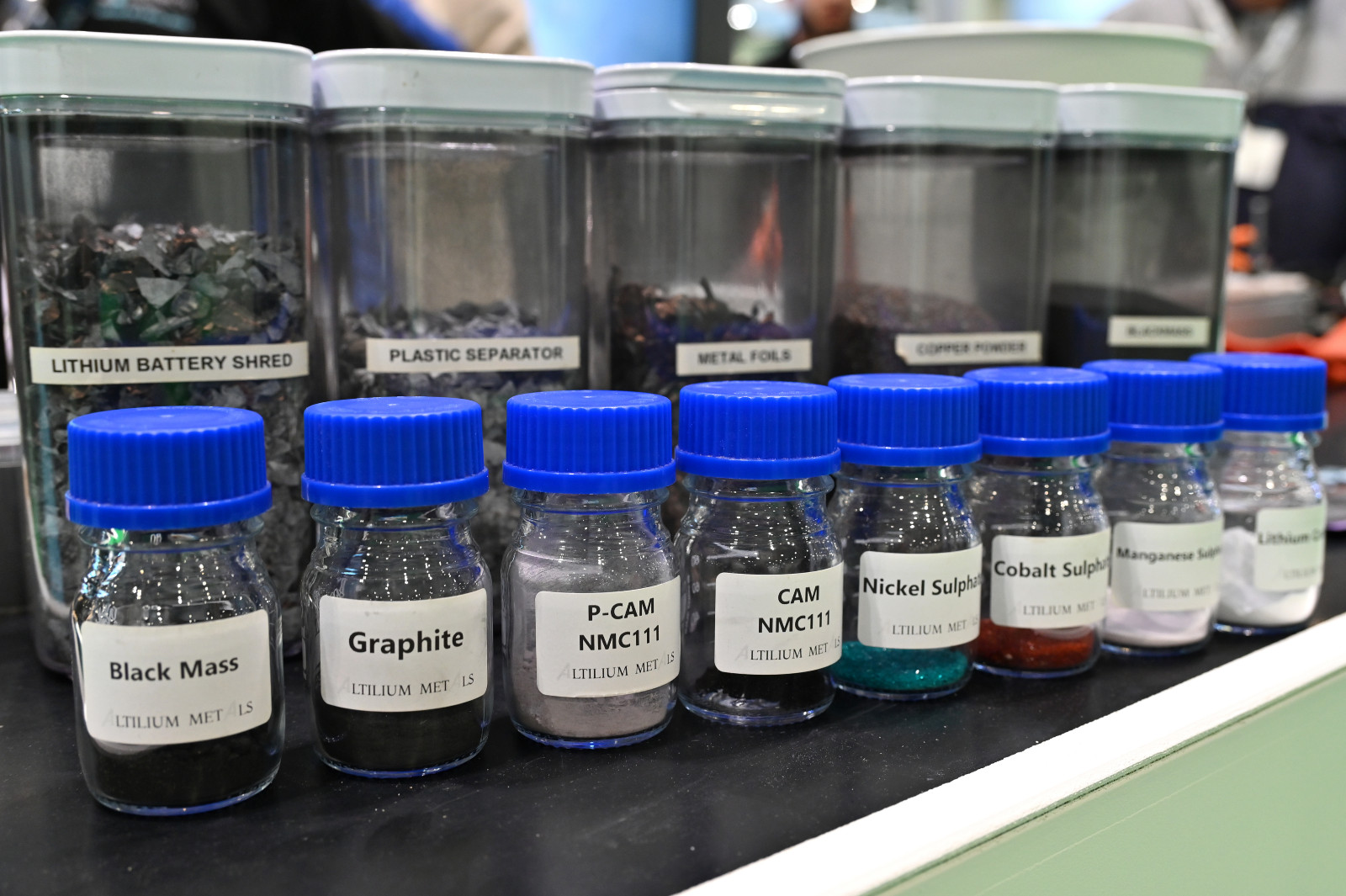
A third approach is direct recycling, in which battery materials are separated and repaired for reuse without any smelting or acid treatment. This gentler process aims to keep the structure of the materials intact. Direct recycling is a newer idea that’s further from commercialization than the other two methods, and there are some challenges scaling it up because it relies on separating materials very cleanly and efficiently. But recent research suggests that for cathode metals, it can have significant environmental and cost benefits. Direct recycling of graphite, Keyser said, has the potential to use “far less energy” than synthetic graphite production.
Today, companies are exploring a range of graphite recycling processes.
American Battery Technology Company has developed an approach that starts with physically separating graphite from other battery materials like cathode metals, followed by a chemical purification step. Additional mechanical and thermal treatments are then used to restore graphite’s original structure. The company is currently recycling graphite at a “very small scale” at its laboratory facilities in Reno, Nevada, Melsert said. But in the future, it plans to scale up to recycling several tons of graphite-rich material a day with the help of a three-year, nearly $10 million Department of Energy grant funded through the 2021 bipartisan infrastructure law.
Massachusetts-based battery recycling startup Ascend Elements has also developed a chemical process for graphite purification. Dubbed “hydro-to-anode,” Ascend Elements’ process “comes from some of the work we’ve done on hydro-to-cathode,” the company’s patented hydrometallurgical process for recycling cathode materials, said Roger Lin, the vice president of global marketing and government relations at the firm. Lin said that Ascend Elements is able to take graphite that’s been contaminated during an initial shredding step back to 99.9 percent purity, exceeding EV industry requirements, while also retaining the material properties needed for high performance anodes. In October, Ascend Elements and Koura Global announced plans to build the first “advanced graphite recycling facility” in the U.S.
The Department of Energy-backed startup Princeton NuEnergy, meanwhile, is exploring direct recycling of graphite. Last year, Princeton NuEnergy opened the first pilot-scale direct recycling plant in the U.S. in McKinney, Texas. There, batteries are shredded and a series of physical separation processes are used to sort out different materials, including cathode and anode materials. Cathode materials are then placed in low-temperature reactors to strip away contaminants, followed by additional steps to reconstitute their original structure. The same general approach can be used to treat anode materials, according to founder and CEO Chao Yan.
“From day one, we are thinking to get cathode and anode material both recycled,” Yan said. But until now, the company has focused on commercializing direct recycling for cathodes. The reason, Yan said, is simple: “No customer cared about anode materials in the past.”
That, however, is beginning to change. Yan said that over the past year — and especially in the last few months since China announced its new export controls — automakers and battery manufacturers have taken a greater interest in graphite recycling. Melsert also said that he’s starting to see “very significant interest” in recycled graphite.
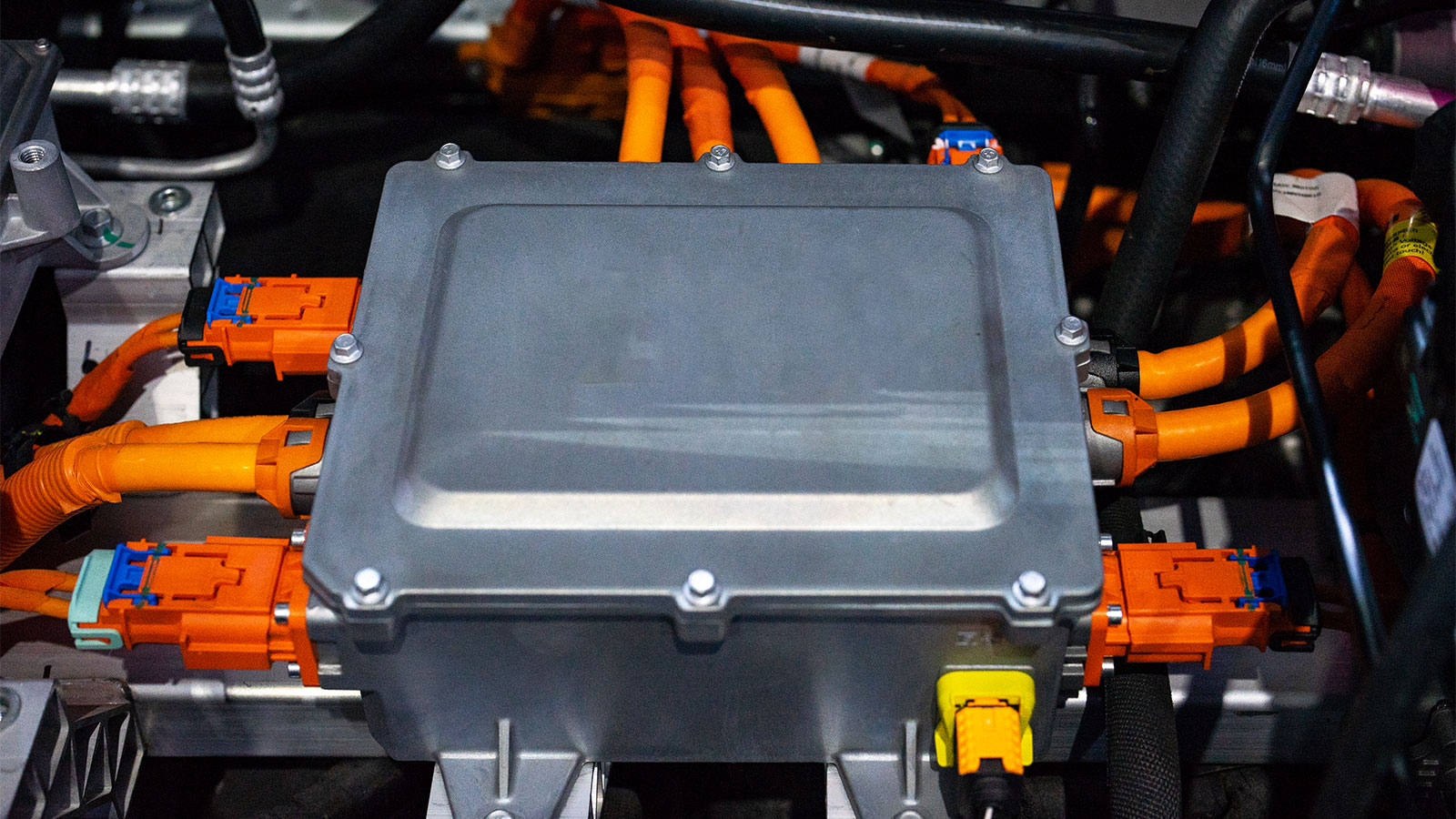
Still, customers will have to wait a little longer before they can purchase recycled graphite for their batteries. The methods for purifying and repairing graphite still need refinement to reduce the cost of recycling, according to Brian Cunningham, the batteries R&D program manager at the Department of Energy’s Vehicle Technologies Office. Another limiting step is what Cunningham calls the “materials qualification step.”
“We need to get recycled graphite to a level where companies can provide material samples to battery companies to evaluate the material,” Cunningham said. The process of moving from very small-scale production to levels that allow EV makers to test a product, “could take several years to complete,” he added. “Once the recycled graphite enters the evaluation process, we should start to see an uptick in companies setting up pilot- and commercial-scale equipment.“
Supply chain concerns could accelerate graphite recycling’s journey to commercialization. Over the summer, the Department of Energy added natural graphite to its list of critical materials for energy. Graphite is also on the U.S. Geological Survey’s list of critical minerals — minerals that are necessary for advanced technologies but at risk of supply disruptions.
This classification means that domestically sourced graphite can help EVs qualify for the “clean vehicle credit,” a tax credit that includes strict requirements around critical mineral sourcing following the 2022 Inflation Reduction Act. To qualify for the full credit, EV makers must obtain a large fraction of their battery minerals from the U.S. or a free-trade partner. By 2025, their vehicles may not contain any critical minerals extracted or processed by a “foreign entity of concern” — an entity connected to a shortlist of foreign countries that includes China. This requirement could “drive a premium” for domestically recycled graphite, Lin said.
Tax incentives could be key to helping recycled graphite compete with virgin graphite, according to Yuan Gu, a graphite analyst at the consulting firm Benchmark Mineral Intelligence. Despite China’s new export controls, Gu expects graphite to remain relatively cheap in the near future due to an “oversupply” of graphite on the market right now. While Gu said that graphite recycling is “definitely on radar for Western countries” interested in securing future supplies, its viability will depend on “how costly or cheap the recycled material will be.”
If graphite recycling does catch on, industry insiders are hopeful it will be able to meet a significant fraction of the country’s future graphite needs — which are growing rapidly as the clean energy transition accelerates — while making the entire EV battery supply chain more sustainable.
“You can help regional supply chains, you can help with efficiency, with carbon footprints,” Lin said. “I think it’s a no-brainer this will happen.”
This story was originally published by Grist with the headline The next frontier in EV battery recycling: Graphite on Jan 5, 2024.

On Tuesday, a federal appeals court decided not to revisit its earlier decision to strike down Berkeley, California’s first-in-the-nation gas ban in new buildings. The ruling dealt a blow to the city of Berkeley, which requested a rehearing after the 9th U.S. Circuit Court of Appeals’ initial decision in April, and casts uncertainty over similar policies to electrify buildings in dozens of other cities.
In effect, the court simply chose to uphold its earlier judgment in April to invalidate Berkeley’s gas ban, legal experts told Grist. But unless the city of Berkeley chooses to appeal the case to the Supreme Court, the 9th Circuit’s judgment is now final. (The Berkeley city attorney’s office did not respond to a request for comment on its next steps in time for publication.) That means that for cities in the 9th Circuit region, which spans 11 western states and territories including California, Oregon, and Washington, local gas bans similar to Berkeley’s are no longer legal.
“For cities in the 9th Circuit that have laws that are modeled closely on the Berkeley ordinance, this is a door closing,” said Amy Turner, director of the Cities Climate Law Initiative at Columbia University’s Sabin Center for Climate Change Law.
In 2019, Berkeley became the first city in the country to pass a ban on installing natural gas piping in new buildings, requiring all-electric appliances. Dozens of cities across the 9th Circuit region, including more than 70 in California alone, quickly followed suit, drafting new laws to reduce greenhouse gas emissions and indoor air pollution.
But later that year, the California Restaurant Association initiated a lawsuit against Berkeley’s policy, arguing that natural gas stoves were essential for preparing foods like “flame-seared meats” and “charred vegetables.” In 2021, a federal district court ruled against the restaurant industry, but that decision was overturned in April 2023 by the 9th Circuit. That court held that national energy efficiency standards preempted Berkeley’s law, which would in effect prevent the use of gas-powered appliances that meet federal standards. The city of Berkeley requested a rehearing of the case before 11 judges on the 9th Circuit — a petition that was denied in this week’s decision.

Sarah Jorgensen, a lawyer for the California Restaurant Association, told the San Francisco Chronicle that the judges had acknowledged that “energy policy was a matter of national concern and that there should be uniform national regulation.” Sean Donahue, a lawyer for the city of Berkeley, called the order disappointing and stated that Berkeley’s ordinance “is well within its authority to protect the health and safety of its own residents,” according to the Chronicle.
Tuesday’s denial featured a detailed dissent authored by U.S. Circuit Judge Michelle Friedland and seven other judges on the 9th Circuit. “Climate change is one of the most pressing problems facing society today, and we should not stifle local government attempts at solutions based on a clear misinterpretation of an inapplicable statute,” wrote Friedland. “I hope other courts will not repeat the panel opinion’s mistakes.”
Including any dissent at all is highly unusual for an action as rote as denying a petition, said Turner. “It seems like she is attempting to bolster the cases of other states and local governments that might be looking to pursue building electrification policies and providing a legal road map for why other courts should find a Berkeley-style ordinance to be lawful,” Turner noted.
In the United States, buildings account for nearly a third of all greenhouse gas emissions. For cities motivated to electrify their buildings, Tuesday’s denial of a rehearing is a “disappointing outcome,” said Jim Dennison, an attorney working on building decarbonization at the Sierra Club. Since the April ruling, several cities in California have already pulled back their own natural gas bans, including Encinitas, Santa Cruz, and San Luis Obispo, to avoid legal risks. Eugene, Oregon, which modeled its policy on Berkeley’s, also withdrew its gas ban in June.
Yet some cities, including Los Angeles, San Francisco, and San Jose, still have natural gas bans on the books. Tuesday’s decision could inspire those cities to take action, but ultimately, whether they decide to halt or maintain their gas bans is up to each individual government, said Turner. It could also depend on the resources they have available to take on potential legal challenges.

“Local governments have different appetites for legal risk, and so they chose to navigate this decision and this time in different ways,” Turner said. The legal uncertainty created by the Berkeley decision especially impacts smaller communities that may not have the staff and financial resources to take on potential litigation, she said. “This uncertainty is going to cause some local governments to pull back a bit. And that’s an unfortunate reality of being a local government. They don’t always have the resources that a San Francisco or a Berkeley has to throw behind a challenge like this.”
Both Turner and Dennison emphasized that despite a setback to local gas bans, city officials still have a wide range of options available for electrifying buildings, including building codes and air pollution standards. Dennison highlights Washington state’s recently updated building codes as one legally robust way to reduce emissions from buildings. The codes, which set minimum energy efficiency standards, will require new buildings to achieve the same energy performance as buildings that use electric heat pumps beginning this year. Notably, they offer building owners flexibility in meeting the benchmarks instead of requiring them to install heat pumps or forgo natural gas.
Local governments can also consider setting emissions standards for buildings and appliances, which concern air pollution rather than energy use. That’s an approach taken by New York City, which prohibits new buildings from emitting more than a certain amount of carbon dioxide pollution. Turner notes that state utility regulators can also take steps to limit the expansion of natural gas infrastructure, which could also serve building electrification goals.
“Cities are extremely motivated to address emissions from their buildings, which are an incredibly important source of climate and health-harming pollution,” said Dennison. “And I don’t think that this court order can stand in the way of that progress.”
This story was originally published by Grist with the headline Berkeley’s gas ban is all but dead. What does that mean for other cities? on Jan 5, 2024.
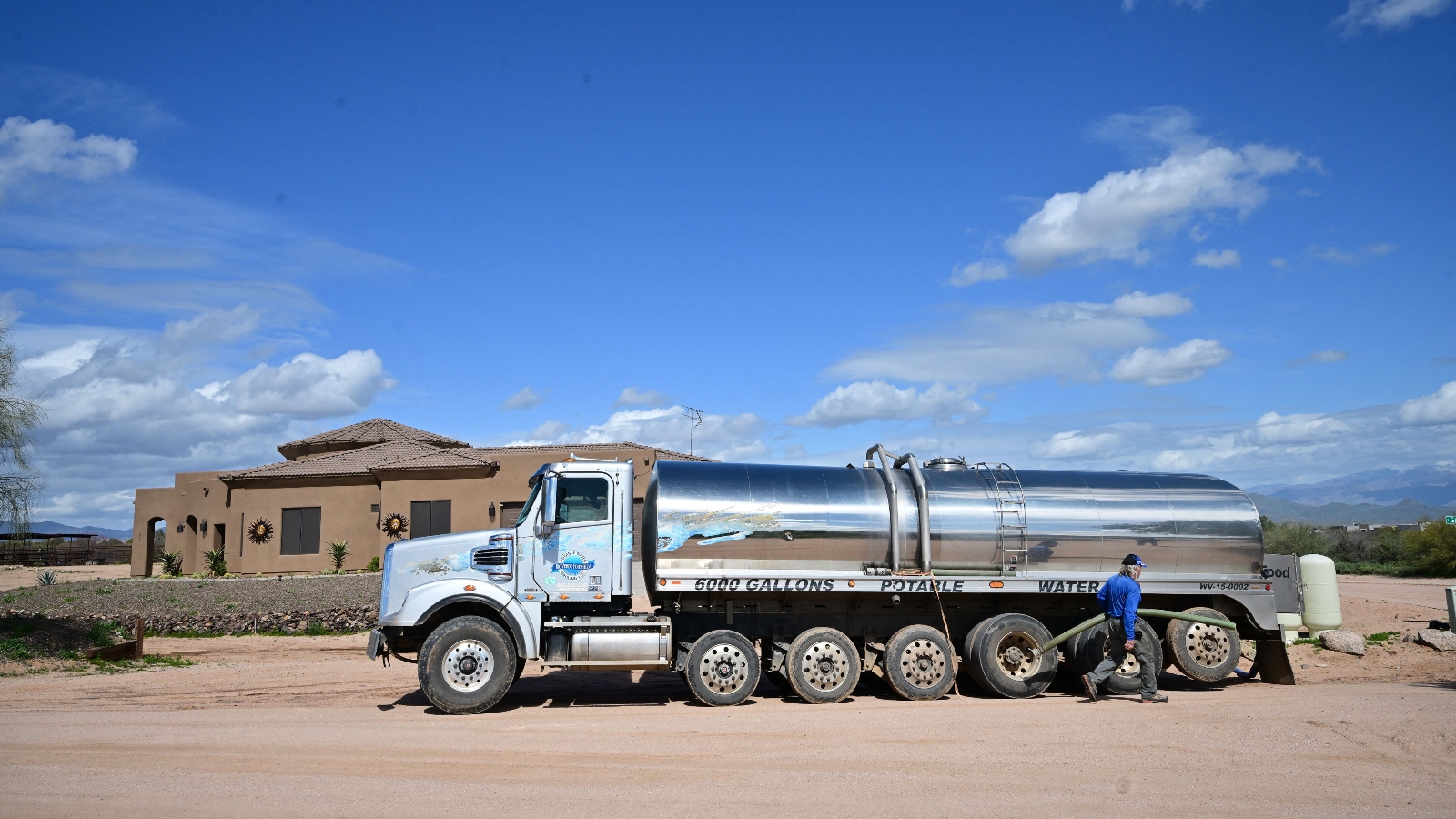
When a small Arizona community called Rio Verde Foothills lost its water supply one year ago, forcing locals to skip showers and eat off paper plates, it became a poster child for unwise desert development. The rural neighborhood of about 2,000 people north of Phoenix had relied on trucked-in water deliveries from the nearby city of Scottsdale, but the city elected to stop deliveries to conserve its own water amid a climate-fueled drought on the Colorado River.
Last month, after months of public debate over how to resolve the crisis in Rio Verde Foothills, the state government approved a deal that will restore permanent water access to the beleaguered community, albeit with much higher bills than residents are used to. But when the new legislative session begins next week, the Republican-led chamber may actually weaken the standards that govern new development, rather than tightening them, clearing the way for thousands more homes to pop up on water-insecure outskirts of Phoenix and Tucson.
“The broader solutions are tougher, and people may not be ready to contemplate what really fixing the problem would require,” said Priya Sundareshan, a Democratic state senator who represents part of Tucson.
When Arizona developers build six or more homes on a tract of land, they have to demonstrate that they can supply water to those homes for at least a hundred years. This rule exists to protect home buyers from the kind of land fraud that was notorious in the state for decades, but over time some landowners have found a way around it. The developers of so-called “wildcat” subdivisions split large parcels of land into smaller chunks and sell hundreds of those chunks off one by one, skirting the requirement to ensure a long-term water supply.
Rio Verde Foothills is one such subdivision. Many residents of the neighborhood have residential wells that pump water from underground. But because there isn’t much water in the area’s aquifers, many others rely on trucks that deliver water from the city of Scottsdale, which has rights to water from the Colorado River. When Scottsdale shut off the water last year, Rio Verde had nowhere to turn for substitute supplies: There was no spare groundwater, and all the water from the Colorado River was spoken for. Locals who found alternate water haulers had to pay monthly bills that were larger than their mortgage payments.
As the media frenzy around Rio Verde Foothills reached a fever pitch last summer, the state legislature passed a bill that forced Scottsdale to provide water to the neighborhood through 2025. A few months later, a state regulator approved a long-term agreement between the community and a large utility called Epcor, which agreed to build a new water standpipe in the neighborhood and import a new water supply from elsewhere in Phoenix. Rio Verde Foothills residents will pay for the $12 million project through water bills that could be double or triple current rates. The deal also limits future growth in the neighborhood, allowing for just 150 additional homes to access the standpipe.
“It’s been an exhausting, exhausting fight for this community, and people are not happy with how much it costs,” said John Hornewer, a Rio Verde resident who runs the neighborhood’s largest water hauling company.
But the state legislature’s fix doesn’t address the larger problems presented by wildcat subdivisions. While Democrats and some Republicans in the legislature sought to add language that would have limited when and how developers can exploit the wildcat loophole, they couldn’t get enough support to send it to the governor’s desk. Democratic Governor Katie Hobbs initially held out for a fix to the loophole — she vetoed an initial bill in May that didn’t tackle the wildcat issue — but she ultimately signed a Rio Verde-focused bill that reached her desk the following month, acknowledging that the neighborhood needed immediate help.
“The bill did not do anything to fix the underlying problem,” said Sundareshan, the state senator from Tucson. “We could find ourselves with many more communities … in the same situation.”

Hobbs has continued to push for broader reform on the wildcat issue. Last year she created a “water policy council” made up of experts and industry leaders and tasked it with alleviating the state’s water woes, including the wildcat loophole. The council released its final recommendations in December, calling on the legislature to clamp down on these subdivisions and give local governments more power to regulate them. It isn’t clear how many such subdivisions exist, but they have been popping up outside Phoenix and Tucson for at least two decades.
Democratic lawmakers will make another push once the state’s legislative session starts next week, but Hobbs’s proposed reforms still face stiff opposition. Many members of the state legislature oppose more government involvement in water regulations, and the state’s home building lobby has fought against previous efforts to clamp down on the kind of lot-splitting that enables wildcat development.
“There’s an appetite for [reform], but I think that will be lost in the shuffle,” said John Kavanagh, a Republican state senator who represents the Rio Verde Foothills area. “The home builders will be aggressively lobbying against a lot-split bill, and you’ve got some members with a more libertarian slant who believe in the right to property being almost unlimited.”
Indeed, home builders are now pushing the legislature to move in the other direction, arguing that the 100-year water supply standard is holding back the state’s economic growth. Back in June, Hobbs’s administration paused new water supply approvals in the Phoenix area, declaring that the city’s aquifers didn’t have enough water to support future development over the next century. This has left several major development projects in limbo, with builders unable to move forward on tens of thousands of homes.
Hobbs’s administration has since moved to loosen the moratorium in response to protest from the real estate industry, and regulators may soon allow builders in fast-growing suburbs like Buckeye to resume construction on stalled projects. But the state’s builders are seeking more comprehensive changes to the 100-year water supply standard: They argue that lawmakers should create an incentive for replacing water-intensive crop fields with residential neighborhoods, which require far less water than large-scale agriculture. The builders also argue that lawmakers should tweak the state’s model for calculating groundwater shortages, which they say is too pessimistic.
“If the legislature and the governor’s office don’t agree to the necessary changes to resolve this issue this year, that would be very devastating to our housing affordability, our housing supply, and our economy,” said Spencer Kamps, the vice president of legislative affairs for the Home Builders Association of Central Arizona.
The future of the 100-year requirement is likely to take center stage this year, along with a parallel debate over how to regulate the kind of intensive groundwater pumping that has dried up wells and caused land to sink in rural areas such as Cochise County. That issue became so contentious last year that two members of Hobbs’s water policy council with ties to the agriculture industry, which is responsible for some of the most aggressive pumping, resigned before the council even finished its recommendation.
Until the legislature reforms the wildcat subdivision statute, though, there’s nothing to stop developers from creating more vulnerable neighborhoods in the middle of the desert. Hornewer, the Rio Verde Foothills water hauler, said he’s sure his neighborhood’s crisis will play out again somewhere else.
“It’s probably already happening,” he told Grist.
This story was originally published by Grist with the headline Will Arizona close a loophole that lets developers build without water? on Jan 5, 2024.
Birds of prey in Africa are currently experiencing an extinction crisis, with more than two-thirds potentially threatened, according to a new study by an international research team led by The Peregrine Fund and researchers from the University of St. Andrews.
Of the 42 species profiled in the report, 88 percent have declined over a 20- to 40-year period. Of those, 69 percent exceeded the “at risk of extinction” criteria set forth by the International Union for Conservation of Nature.
“The conversion of natural habitats to farmland is a major cause of biodiversity loss and poses the greatest extinction risk to birds worldwide. Tropical raptors are of particular concern, being relatively slow-breeding apex predators and scavengers, whose disappearance can trigger extensive cascading effects. Many of Africa’s raptors are at considerable risk from habitat conversion, prey-base depletion and persecution, driven principally by human population expansion,” the authors of the study wrote.
The study looked at road surveys from four regions in Africa over 20 to 40 years and examined changing patterns in savanna raptor populations, a press release from the University of St. Andrews said.
“Large raptors had experienced significantly steeper declines than smaller species, and this disparity was more pronounced on unprotected land. Declines were greater in West Africa than elsewhere, and more than twice as severe outside of protected areas (PAs) than within. Worryingly, species suffering the steepest declines had become significantly more dependent on PAs, demonstrating the importance of expanding conservation areas to cover 30% of land by 2030 — a key target agreed at the UN Convention on Biological Diversity COP15,” the study said.
The researchers found that if the multitude of threats African raptors are facing are not sufficiently dealt with, large vulture and eagle species are not likely to survive over much of Africa’s unprotected land by 2050 and beyond, the press release said.
“Since the 1970s, extensive areas of forest and savanna have been converted into farmland, while other pressures affecting African raptors have likewise intensified. With the human population projected to double in the next 35 years, the need to extend Africa’s protected area network – and mitigate pressures in unprotected areas – is now greater than ever,” said Dr. Phil Shaw of the University of St. Andrews’ School of Biology in the press release.
The study, “African savanna raptors show evidence of widespread population collapse and a growing dependence on protected areas,” was published in the journal Nature Ecology and Evolution.
The study underscored the drastic declines among raptors that have been classified by the global Red List of Threatened Species as of “least concern.” These species include the African hawk-eagle, the African harrier-hawk, the long-crested eagle, Wahlberg’s eagle, the dark chanting goshawk and the brown snake-eagle. These species have all experienced rates of population decline that suggest they could currently be threatened worldwide.
“Africa is at a crossroads in terms of saving its magnificent birds of prey. In many areas we have watched these species nearly disappear. One of Africa’s most iconic raptors, the Secretarybird, is on the brink of extinction. There’s no single threat imperiling these birds, it’s a combination of many human-caused ones, in other words we are seeing deaths from a thousand cuts,” said Dr. Darcy Ogada of Idaho-based The Peregrine Fund.
Other previously common species of raptors that have become absent or scarce from lands that are unprotected include the elegantly feathered bateleur eagle and the splendid martial eagle.
“This was the continent over which, only 50 years ago, pristine populations of spectacular raptors were evident almost everywhere, bringing excitement and wonder to visitors from many parts of the world,” said leading ornithologist professor Ian Newton, who was not part of the research team, in the press release. “The causes of the declines are many – from rampant habitat destruction to growing use of poisons by farmers and poachers and expanding powerline networks – all ultimately due to expansions in human numbers, livestock grazing and other activities. Let us hope that more research can be done and, more importantly, that these birds can be protected over ever more areas, measures largely dependent on the education and goodwill of local people.”
African raptors’ food supplies, habitat and breeding sites have all been greatly reduced on unprotected lands, while mistreatment by farmers, ivory poachers and “pastoralists” has become common.
“[T]he human footprint is particularly high throughout West Africa’s savannas, and the near complete disappearance of many raptors outside that region’s relatively small and fragmented protected area network reflects an ecological collapse that is increasingly affecting other parts of the continent. Some raptors that occur mostly in West Africa, such as the little-known Beaudouin’s Snake-eagle, are vanishing into oblivion,” said Dr. Ralph Buij of The Peregrine Fund, who conducted repeat surveys of some original areas, in the press release.
The study’s findings point to the crucial nature of making the protection of the continent’s natural habitats stronger in alignment with the goal of the COP15 United Nations Biodiversity Conference to expand conservation areas to protect 30 percent of land globally by 2030. They also show the necessity of restoring habitats in unprotected areas, improving species protection legislation, reducing energy infrastructure impacts and establishing long-term evaluation and monitoring of African raptors’ conservation status. Public participation in efforts to conserve these majestic species must also be increased.
To help achieve these goals, the authors of the study developed the African Raptor Leadership Grant to fund conservation programs and additional research, boost local conservation initiatives, support mentoring and educational opportunities for emerging scientists in Africa and increase raptor knowledge all over Africa.
The post Africa’s Birds of Prey Are Experiencing an Extinction Crisis appeared first on EcoWatch.
In 2023, 55 percent of Germany’s power came from renewables — an increase of 6.6 percent, according to energy regulator Bundesnetzagentur, reported Reuters.
Europe’s biggest national economy has a goal of 80 percent green energy by 2030. The country plans to get rid of most of its coal, has already ceased relying on nuclear power and in the future intends to use gas primarily as backup for its energy grid.
“We have broken the 50 per cent mark for renewables for the first time,” said Robert Habeck, Germany’s vice chancellor and federal minister for economic affairs and climate action, in a statement, as The National reported. “Our measures to simplify planning and approvals are starting to take effect.”
Germany’s renewables mix included 31.1 percent from wind, 12.1 percent from solar and biomass and 3.4 percent from a mixture of hydropower and other renewable sources, according to a press release from Bundesnetzagentur.
“Wind farms – especially those on land – made the largest contribution,” the press release said.
The energy sector regulator said the renewables increase in 2023 was bolstered by weather and an expansion of capacity, reported Reuters.
“There is an interaction between supply and demand across the whole of Europe. Electricity is produced within Europe wherever it is cheapest. Germany and the other European countries can all benefit from the most favourable conditions for generation in each case. The wholesale electricity prices and trading are the result of this interplay,” the press release said.
Power grids are supervised by the energy regulator while being consumer-funded and have to make the continuous transition from centralized fossil fuels operations to the millions of smaller, decentralized providers made up of mostly solar and wind, Reuters reported.
The total amount of power supplied by Germany’s public networks decreased by 5.3 percent last year, indicating less demand for fossil fuels in favor of renewables.
“Generation from conventional sources totalled 197.2 TWh, down 24.0% from 2022,” the press release said. “Overall, generation from hard coal was 36.8% lower and from lignite 24.8% lower in 2023 than in 2022.”
The country’s economy continued to feel the effects of Russia’s invasion of Ukraine and the decline of energy imports and resulting price increases that followed in 2022, reported Reuters.
“Electricity produced from natural gas rose 31.3% year-on-year. There were several factors contributing to the continued use of natural gas to generate electricity despite the war in Ukraine and efforts to save gas,” Bundesnetzagentur said in the press release.
“[T]here may be times when it makes sense to import or export electricity for economic, rather than supply-related, reasons. Network capacity and stability also play a role in trading flows. The European internal market for electricity thus contributes to lower electricity prices and lower carbon emissions,” Bundesnetzagentur said.
The post Germany Reached 55% Renewable Energy in 2023 appeared first on EcoWatch.
Researchers completing the first dive survey of Lake Tahoe have found an accumulation of plastic litter in a small section of the lake.
Lake Tahoe, which lies on the border of California and Nevada, is the 10th deepest lake in the world. Last year, researchers from the Desert Research Institute and University of California Davis Tahoe Environmental Research Center collaborated with Clean Up the Lake, a nonprofit focused on cleaning up Lake Tahoe, to send divers into the lake to survey the lakebed.
The divers covered about 9.3 kilometers (5.78 miles) near Lake Tahoe Nevada State Park and Zephyr Cove. In just this small portion of the lake, divers found an average of 83 littered items per kilometer. Hidden Beach and South Sand Harbor lakebeds had higher amounts of waste, about 140 pieces of litter per kilometer in Hidden Beach and 124 littered items per kilometer in South Sand Harbor.
In total, researchers found 673 plastic items. Most of the waste found included food packaging, plastic bags, bottles less than 2 liters and toys, according to Desert Research Institute. Scientists published their findings in Applied Spectroscopy.
“There’s very little work on submerged plastic litter in lakes,” Monica Arienzo, a lead author of the study and an associate research professor of hydrology at Desert Research Institute, said in a statement. “And I think that’s a real issue, because when we think about how plastics may be moving in freshwater systems, there’s a good chance that they’ll end up in a lake.”
Researchers tested the litter samples for chemical composition and found six common polymers across the samples: polyvinyl chloride, polystyrene/expanded polystyrene, polyethylene terephthalate/polyester, polyethylene, polypropylene and polyamide.
These findings can help researchers better understand where larger litter items in the lake are coming from and if they are contributing to microplastic pollution, a known issue in Lake Tahoe.
“When we study microplastics, we only have the chemical information, or the plastic type,” said study co-author Julia Davidson. “We don’t know where it came from — a plastic bag, toy, or otherwise — because it’s just a tiny piece of plastic. But now we can use this litter data to point to the dominant types of plastics and compare them to microplastic data.”
Clean Up the Lake has previously worked on a project to clean up the circumference of Lake Tahoe, which led to a collection of over 25,281 pounds of smaller trash. The organization identified an additional 500 heavy items around the lake to later be removed. In total, the organization has removed 61,541 pounds of litter from the lake from 2018 to now.
As the new research shows, the work is only just beginning. Waste, including a significant amount of plastic, is building up deeper in the lake. In fact, the study researchers found that no section of lakebed in their survey was free of litter. In addition to the cleanups, plastic reduction will be important in reducing the amount of plastic in the lake moving forward.
“There’s a lot of education we can do, as well as continuing to work on reducing the use of those plastics,” Arienzo said. “Because we have to start thinking about turning that plastic pipe off.”
The post Divers Find Plastic Litter Accumulating in Lake Tahoe appeared first on EcoWatch.
The ups and downs make the path to sustainable living feel like a roller coaster…
The post Earth911’s 2024 Mission: Reduce Environmental Impacts By 50% appeared first on Earth911.
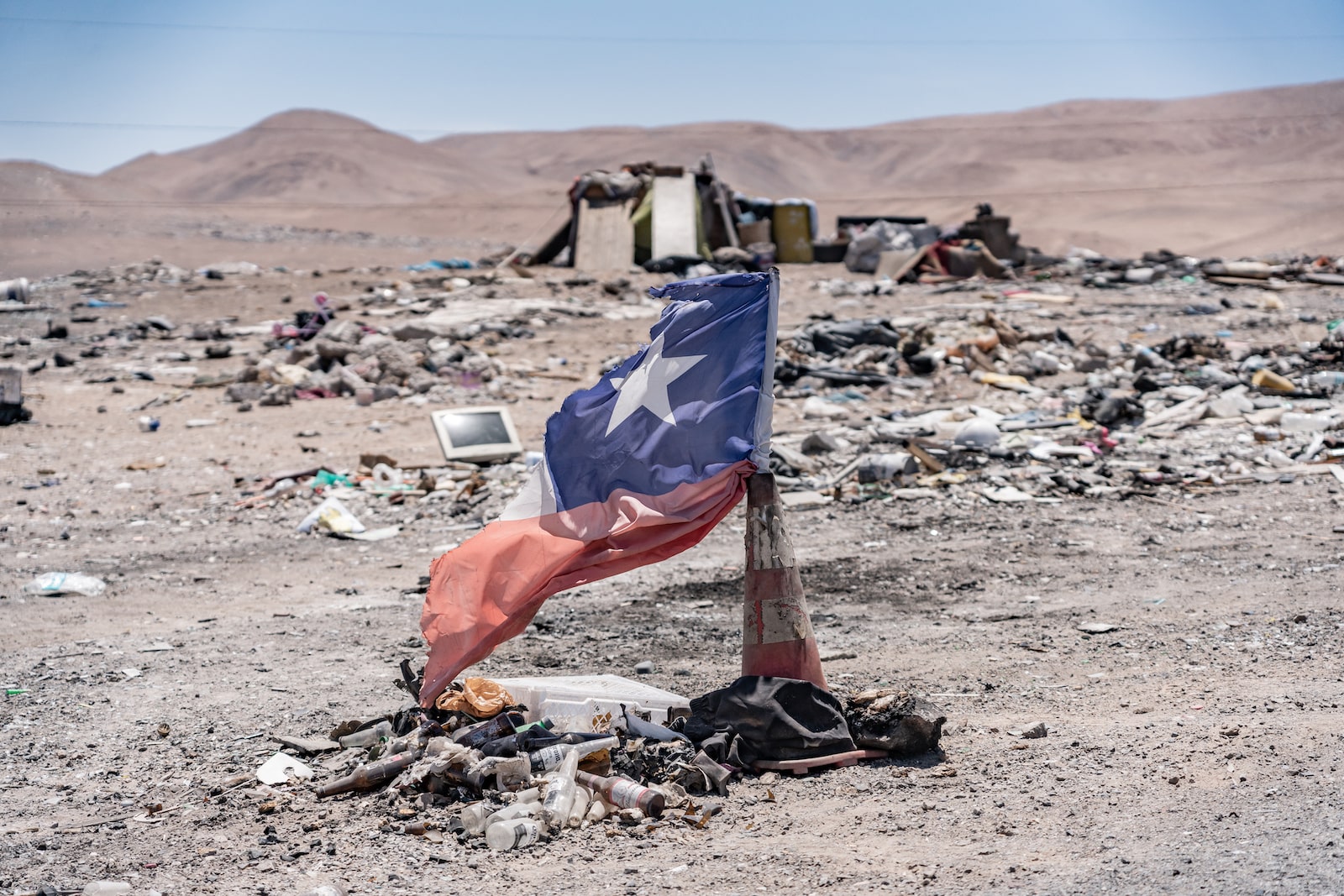
This story was produced by Grist and co-published with El País. A Spanish-language version can be read here. Reporting was supported by the Joan Konner Program in the Journalism of Ideas.
On the morning of June 12, 2022, Ángela Astudillo, then a law student in her mid-20s, grabbed her water bottle and hopped into her red Nissan Juke. The co-founder of Dress Desert, or Desierto Vestido, a textile recycling advocacy nonprofit, and the daughter of tree farmers, Astudillo lives in a gated apartment complex in Alto Hospicio, a dusty city at the edge of the Atacama Desert in northern Chile, with her husband, daughter, bunny, and three aquatic turtles.
Exiting the compound, Astudillo pinched the wheel, pulled over next to a car on the side of the road, and greeted Bárbara Pino, a fashion professor, and three of her students, who were waiting inside.
They headed toward a mountain of sand known as El Paso de la Mula. Less than a mile from her home, squinting into the distance, Astudillo saw a thread of smoke rising from its direction. With her in the lead, the two vehicles caravanned toward the dune, the site of the second-largest clothes pile in the world.
As they got closer to El Paso de La Mula, the thin trail of smoke had expanded into a huge black cloud. Astudillo stopped the car and texted the academics behind her.
It looks like it’s on fire. Hopefully, it’s not there. 🙁 🙁 🙁
She then dialed them directly and asked, “Do you still want to go?”

Pino, director of Santiago’s Fashion System Observatory at Universidad Diego Portales, had planned this trip for months. Astudillo had volunteered to be their guide. The mound of discarded fabric in the middle of the Atacama weighed an estimated 11,000 to 59,000 tons, equivalent to one or two times the Brooklyn Bridge.
By the time the team reached the gates of El Paso de la Mula, more than half of the clothes pile was on fire. Smoke obscured everything, hanging like an opaque black curtain. Municipal authorities turned the group away, forbidding them to stay on the premises. But Astudillo knew the landscape, so she directed the team to the dune’s far side, where access was still unimpeded.
There, the students surveyed the inferno. It was “like a war,” Pino said. She felt waves of heat. Black smoke unspooled from the burning clothes. The air was dense and hard to breathe. Smoke coated the back of their throats and clogged their nostrils with the acrid smell of melting plastic. They covered their faces, trying not to breathe it in. Then the group heard a series of loud pops as mini explosions burst from within the vast expanse of burning garments.
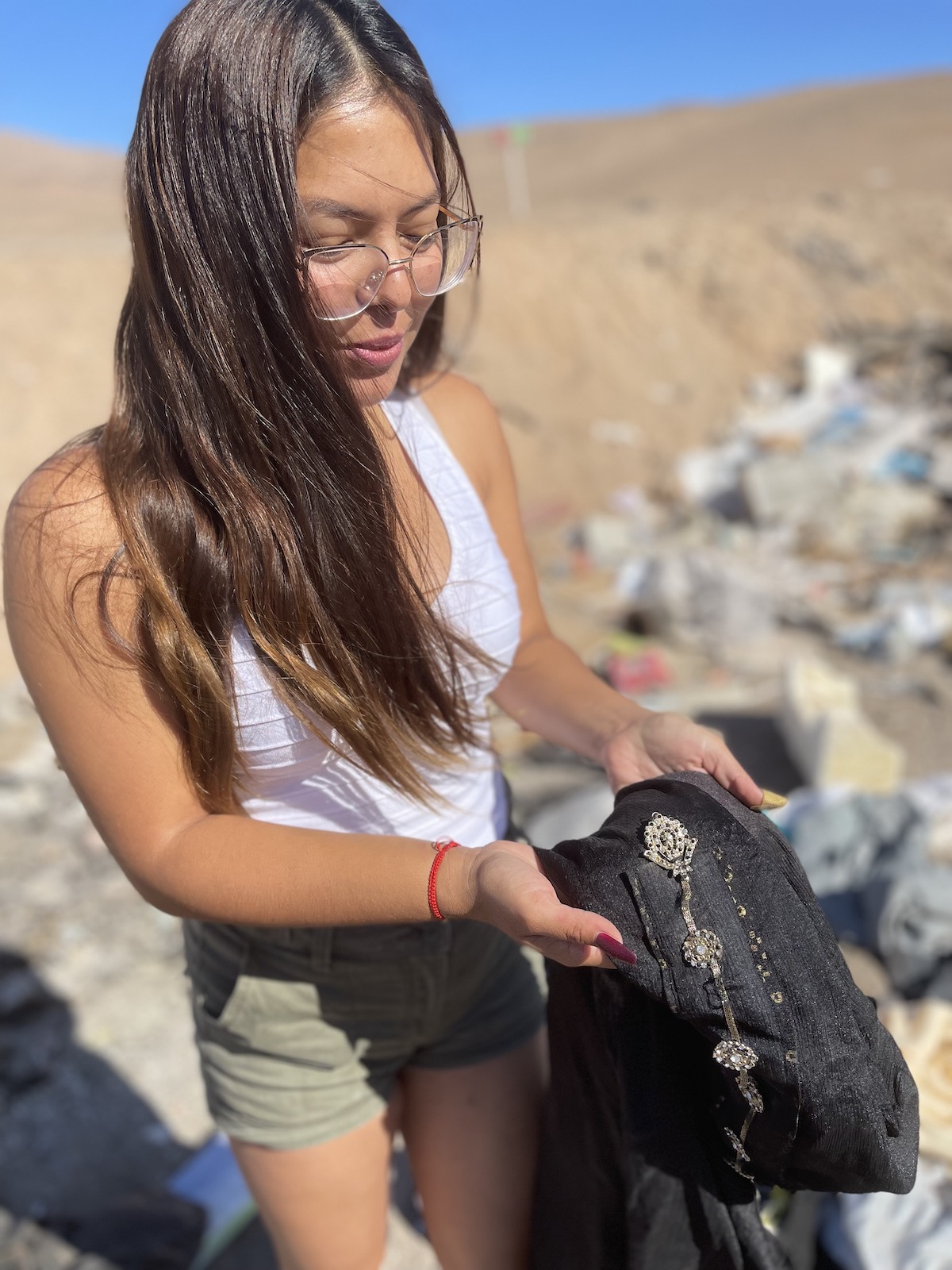
Despite the danger, Pino and her students rummaged, pulling out specimens to examine from among unburned portions of the pile. On prior visits to the clothes dump, Astudillo had uncovered clothing produced by the world’s most well-known brands: Nautica, Adidas, Wrangler, Old Navy, H&M, Ralph Lauren, Tommy Hilfiger, Forever 21, Zara, Banana Republic. Store tags still dangled from many of her findings. The clothes had come to the Atacama from Europe, the United States, Korea, and Japan. Now, as Astudillo began taking pictures and uploading them to Instagram, Pino wandered the mound, horrified and fascinated by the grotesque volume and variety of apparel: ski jackets, ball gowns, bathing suits. She plucked out a rhinestone-encrusted platform stiletto in perfect condition. She crouched to search for its match, but the wind was getting stronger. If it shifted, the team realized, they’d be trapped in the spreading fire.
For 14 years, no rain has fallen in Alto Hospicio or the surrounding Atacama Desert region. Those dry conditions, coupled with the nonbiodegradable, predominantly synthetic, petroleum-derived fibers that modern clothes are made with, meant that the pile never shrank. Instead, for more than two decades, it grew — metastasized — with every discarded, imported item that was added.
In 2021, six months prior to the fire, a photographer from Agence France Presse, Martín Bernetti, captured a bird’s-eye image of this sprawling mound of apparel, essentially an oil slick, strewn across the edge of the Atacama desert.
The aerial image was picked up by news outlets across the globe, from the front page of the New York Post to the BBC, and continues to circulate today. But the mountain of clothes depicted by that 2021 drone photo is utterly gone. As Astudillo, Pino, and the three students witnessed, and unwittingly tasted: The blaze tore through the pile, throwing black plumes of toxic ash into the air.
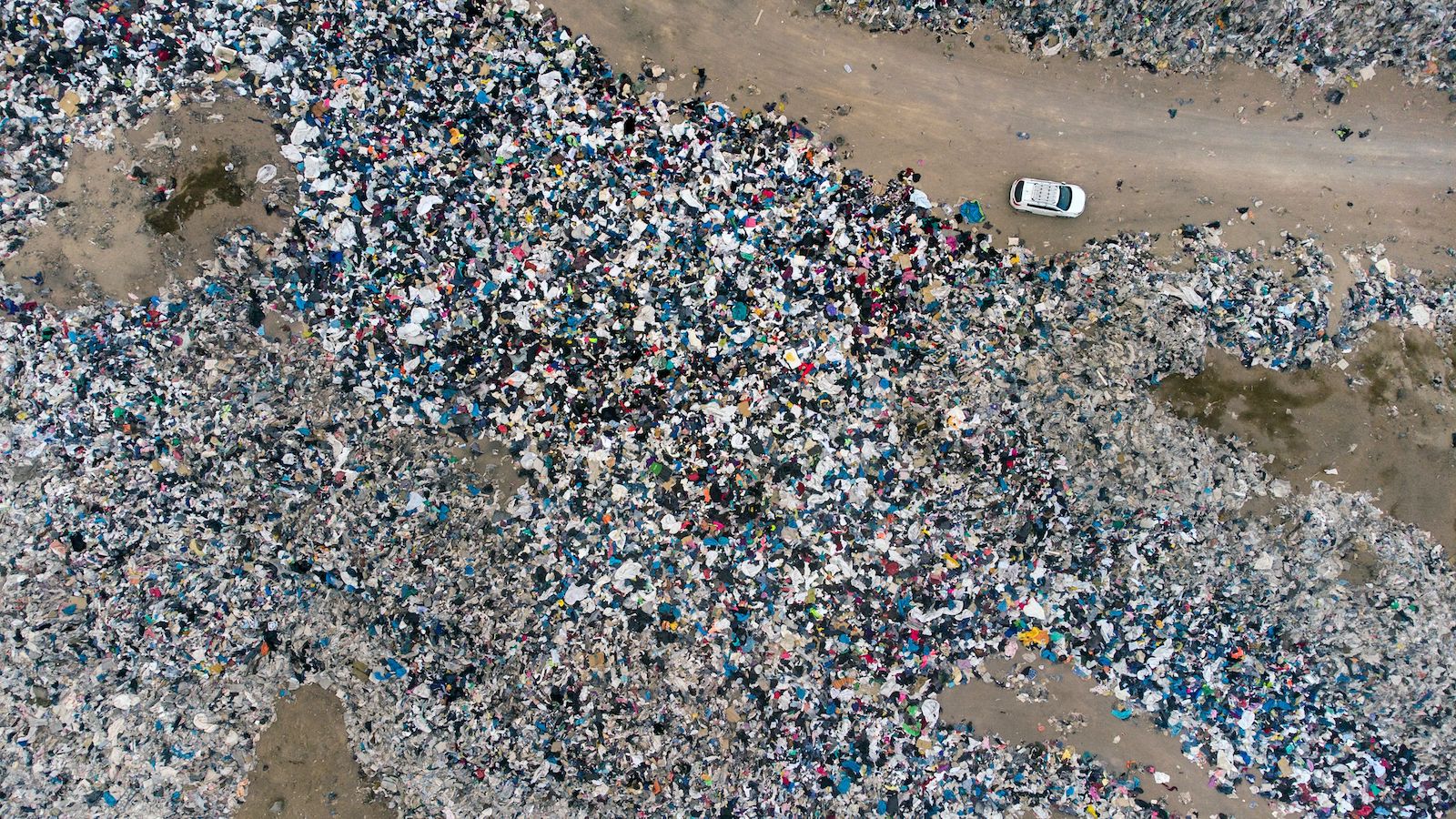
The town of Alto Hospicio sits on a cliff above the Pacific Ocean, a bedroom community for the seaside vacation city of Iquique below. Imagine if Atlantic City in New Jersey were simultaneously hemmed in and backed by a high Nevada plateau, and if the two locales were connected by a two-lane switchback highway.
Each day in Iquique’s port, giant cranes pluck containers full of discarded clothing from the decks of ships and deposit them onto flatbed trucks. No one really knows exactly how much clothing passes through the port every year; estimates range from 60,000 to 44 million tons. Next, they head to the nearby Free Trade Zone, known locally as “Zofri,” where trailers back into the warehouses of 52 used-clothes importers and forklift operators transfer sealed bales of clothing, or fardos, inside.
Chile is the biggest importer of secondhand clothing in South America, and between 2020 and 2021 it was the fastest-growing importer of used clothing in the world. The port of Iquique is an established tax-free zone, incentivizing this booming industry of castaway textiles.
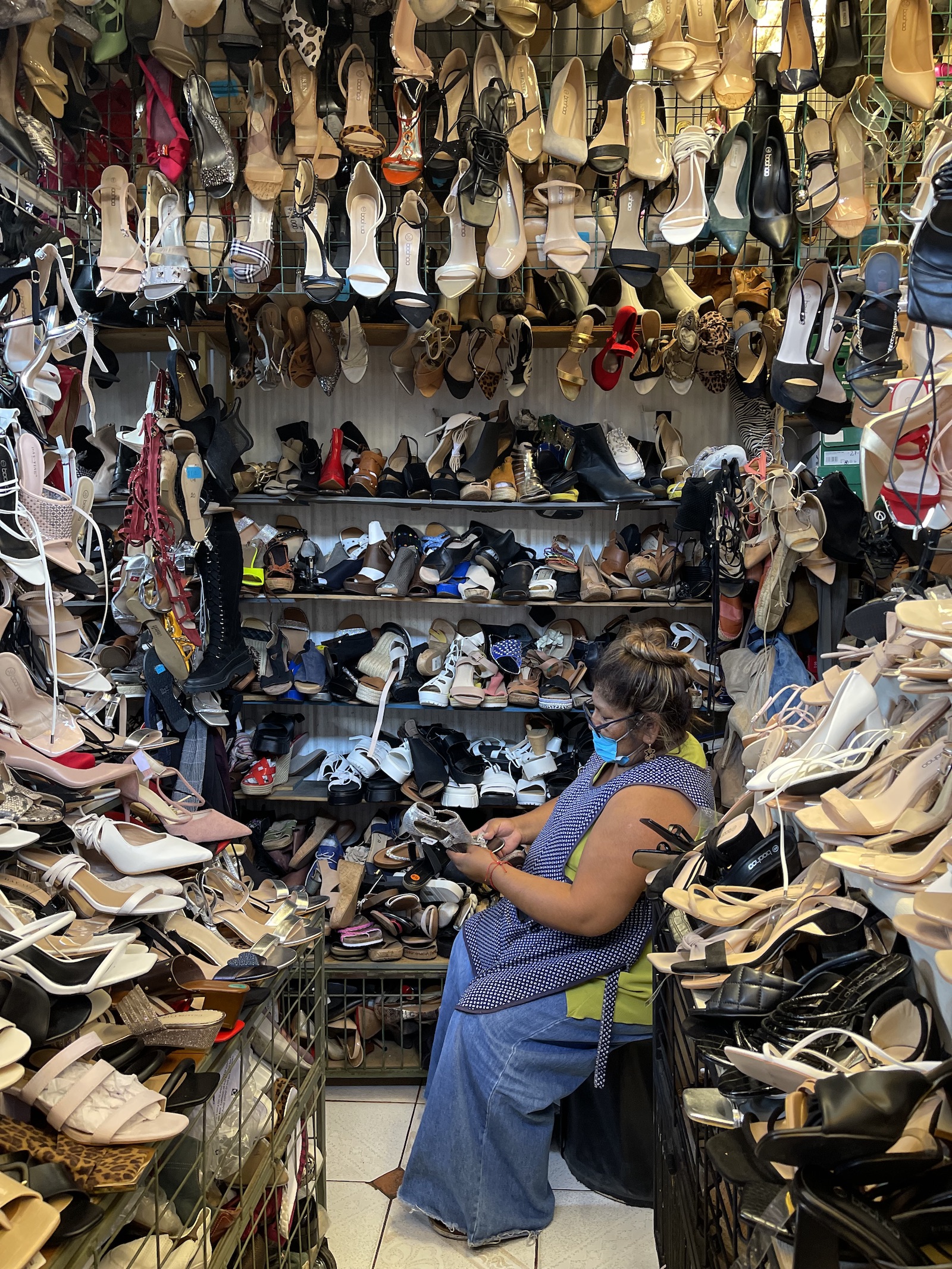
From Zofri, bales of clothing are sold, uninspected, to merchants betting that at least some of the items inside are sales-worthy. “When you buy, you are buying with your eyes closed,” one former merchant said. Sometimes 80 percent of the garments in a bale are usable. Sometimes the opposite is true. Because bales are so cheap, however, most merchants need only sell 40 percent to turn a profit.
According to the global environmental advocacy group Ekō (formerly known as SumofUS), an estimated 85 percent of the used clothing imported into Iquique remains unsold. Chilean federal law states it’s illegal to dispose of textiles.
Considered Iquique’s backyard, Alto Hospicio is one of the poorest cities in Chile, widely known as a place to abandon pets and dump trash. In the late 1990s and early 2000s, the small desert town is where more than a dozen teenage girls mysteriously vanished, until their apprehended killer led authorities to bodies buried in desert graves.
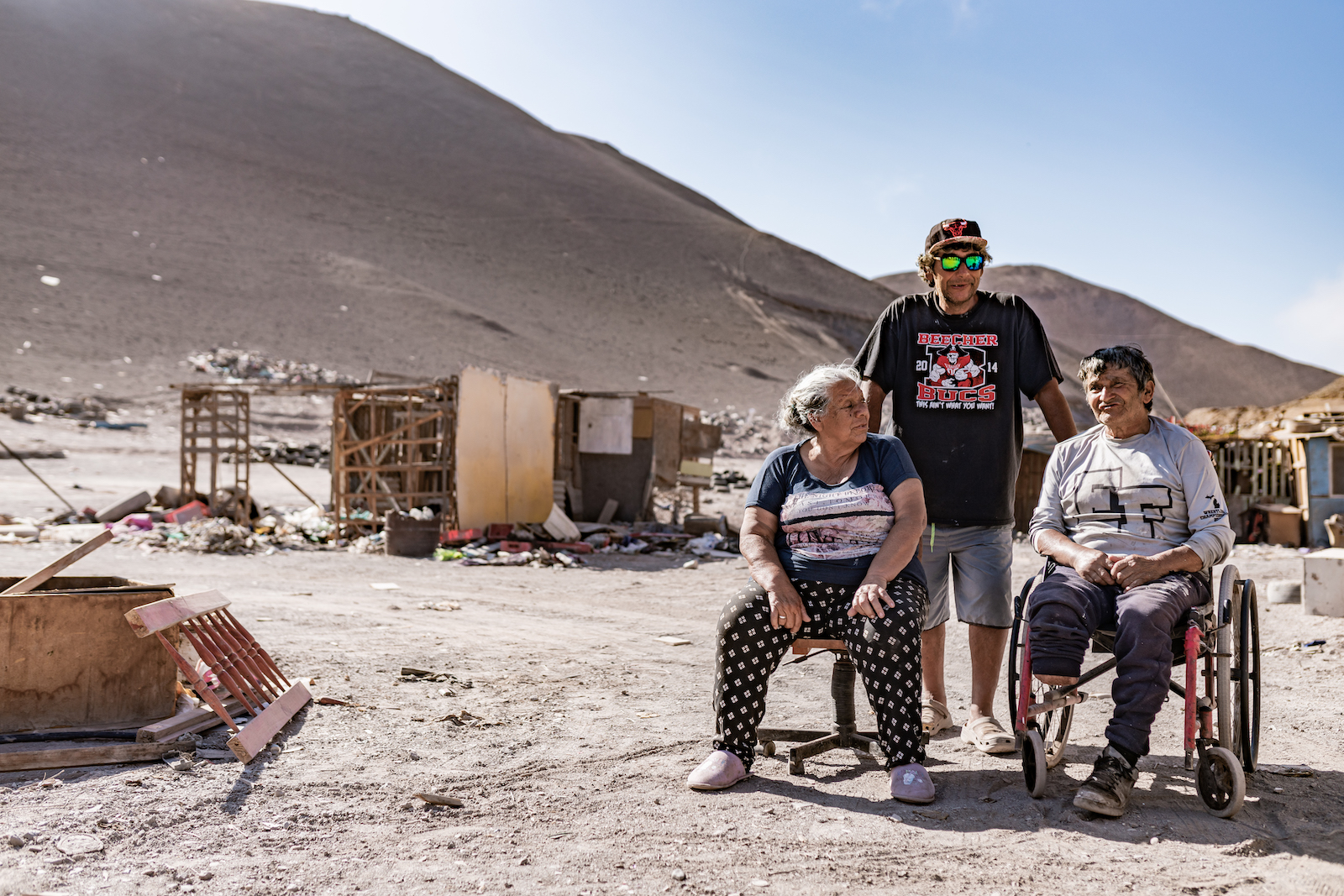
In 2001, Manuela Medina*, a former gardener, saw an opportunity in Iquique’s growing textile abundance. Relocating to Alto Hospicio, she established an unauthorized compound on government lands at the base of El Paso de la Mula, the huge sand dune at the far side of an unregulated shantytown. Every few days, she hired a fletero — a driver with a jalopy — to travel the switchback roads, out of the brown dunes of Alto Hospicio, to arrive in the colorful oceanside city of Iquique, which sits a thousand miles north of the country’s capital, Santiago.
Near the dock where cranes unload massive container ships, inside Iquique’s free trade zone, Medina ventured into the contiguous warehouses, asking secondhand clothing importers, “Do you have any garbage?”
Back at her compound, Medina unloaded her wares in piles on the ground where she had the luxury of storing them indefinitely — the Atacama Desert is one of the driest places on Earth, meaning items don’t undergo normal degradation from elements like rain. Here, Medina sold her piles to merchants and others for $10 each.
As more and more bales of ropa americana, or secondhand clothes, arrived in Iquique, the clothes flooded importers’ warehouses and overflowed vendors’ stalls in open air markets, including La Quebradilla — one of the largest open air markets in South America, located just a few miles from Medina’s unauthorized compound.
Soon, importers and secondhand merchants began to deliver surplus used clothes directly to Medina. Fed by daily truck deliveries, and then by multiple daily tractor trailer load deliveries, Medina’s pile grew.
By 2020, Medina’s gargantuan desert dump had become an open secret in Chile, stretching across dozens of acres. Others followed her model, creating mini-dumps across the desert and along roadsides, but Medina’s pile remained the largest.
On March 29, 2022, Paulin Silva, an environmental lawyer, stood before the Primer Tribunal Ambiental de Antofagasta, a regional tribunal in northern Chile that specializes in resolving environmental issues within its jurisdiction. She was presenting a lawsuit, brought on behalf of herself as a resident of Iquique, against the municipality and the federal Chilean government for their inaction over the sprawling, unregulated clothes dumps. For her submission of evidence, she asked the tribunal to join her in touring the mound of clothing.

For weeks, her informal team of supporters (a geographer, her sister, and her brother-in-law) had been documenting the problem, joking among themselves, “In which dump are we going to party tonight?”
Since obtaining her law degree, Silva has prosecuted a handful of environmental cases, but this one was personal, and she felt empowered to tackle it: “I have the education; I am a lawyer; I can do something,” she said. She’d grown up in northern Chile, a pencil thin country bordered by the Pacific Ocean. Her father is from Alto Hospicio and her mother is from Iquique. At 35, she’s several years older than Astudillo, the co-founder of the nonprofit Dress Desert, whom Silva asked to be a witness for the case. When Silva was a child, she observed people dumping clothes everywhere — the streets, yards, and city squares. Because this was the only place she knew for so much of her life, she thought, “It’s normal for people to live with … garbage accumulated around them.”
This local “clothes-blindness” was documented by Astudillo’s colleague, Bastián Barria, an engineering student and her co-founder of Dress Desert. In November 2020, he and others conducted a survey to ascertain local attitudes regarding the clothing waste. Of the almost 400 people in Alto Hospicio he surveyed, representing less than 1 percent of the town’s population, more than half did not think there was any issue.
When Silva was 18, she moved a thousand miles south, to Valparaiso in central Chile, to study law and that was where she remained until the pandemic, when she returned home. That’s when she realized the dump situation had worsened. Exponentially.
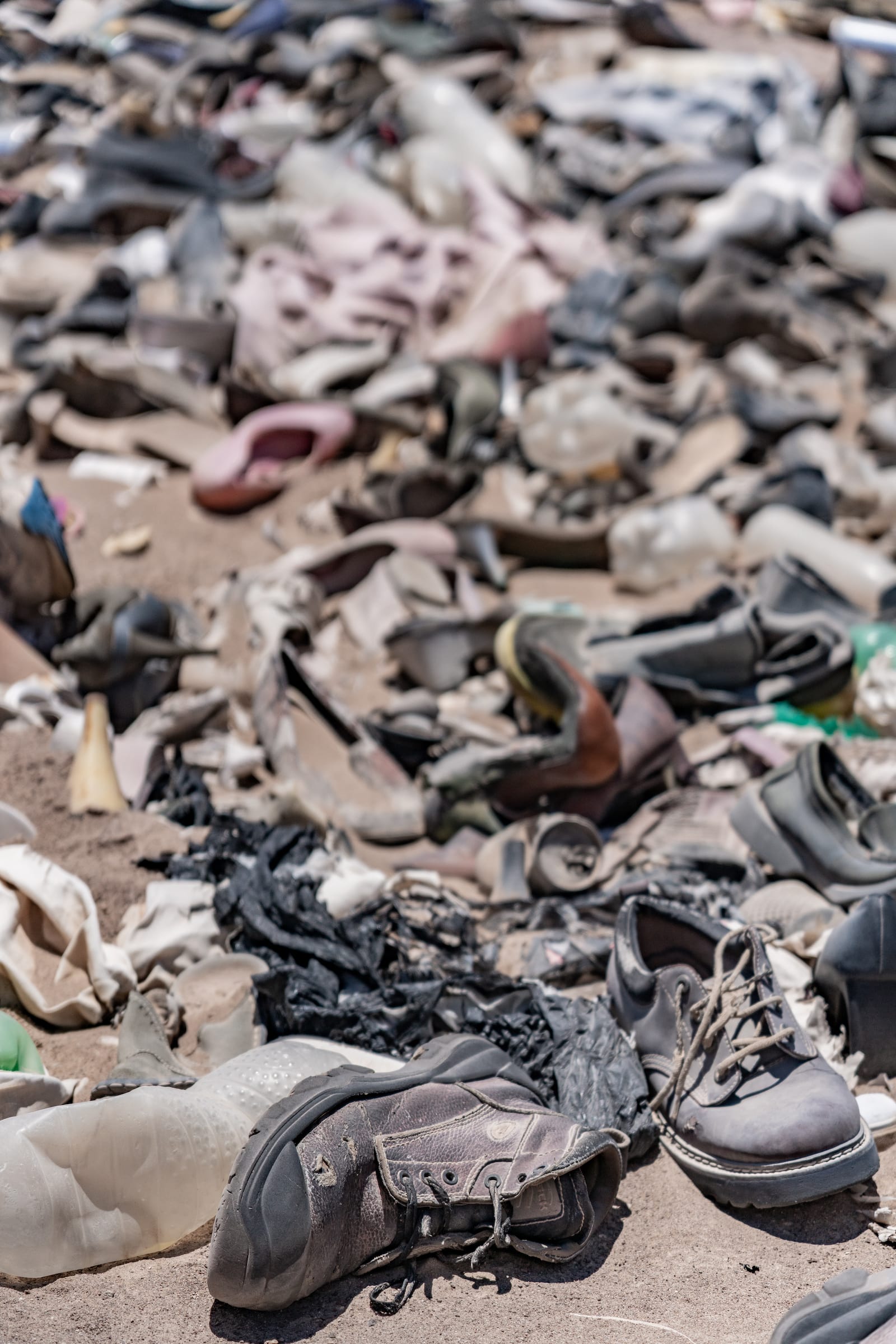
During the decades between Silva’s girlhood and today, clothing production worldwide doubled, while utilization — the number of times an item of clothing is worn before it is thrown away — declined by 36 percent. Countries like Chile, Haiti, and Uganda became depositories for fast fashion discards. In 2021 alone, Chile imported more than 700,000 tons of new and used clothing — the weight equivalent of 70 Eiffel Towers.
“Even if we stopped clothing production throughout the world tonight,” said Francisca Gajardo, an Iquique-born fashion designer, “we still have more garments than we need or that the Earth can safely hold. It won’t go away nicely, and we’re not stopping today.”
Nine days after the giant fires, around 4 p.m., Silva was having a light meal, the Chilean equivalent of afternoon tea known as once (pronounced “on-say”), with her family in northern Chile. A few days prior, the Primer Tribunal Ambiental de Antofagasta had informed her it was ready to view her case evidence by touring the clothes pile in person. Silva took out her phone to share the good news on Instagram with Desierto Vestido, but before she could, she saw the images of the burning clothes Desierto Vestido had just uploaded and shared.
Silva sprang from her chair to process what was happening to the evidence in her case just a few miles away. She suspected why the court had been willing to view the landfill: “Because obviously the matter was burned,” she told Grist.
While no official cause of the fires has ever been reported, local residents claim it began late on Saturday night or in the early hours of Sunday. Days later, toxic air still clung to the area. Astudillo, who visited the site regularly, described the pile as “volcanic” — with clothes smoldering under the sand, venting smoke full of textile chemicals from synthetic materials. She warned, “You can’t be outside for long.”
In the days following the fire, on June 22, instead of leading the tour of the prosecutorial evidence, Silva filed a statement to the Primer Tribunal Ambiental de Antofagasta: “With sadness and shame I inform you that 11,000 tons of clothes in the textile dump were burned.”
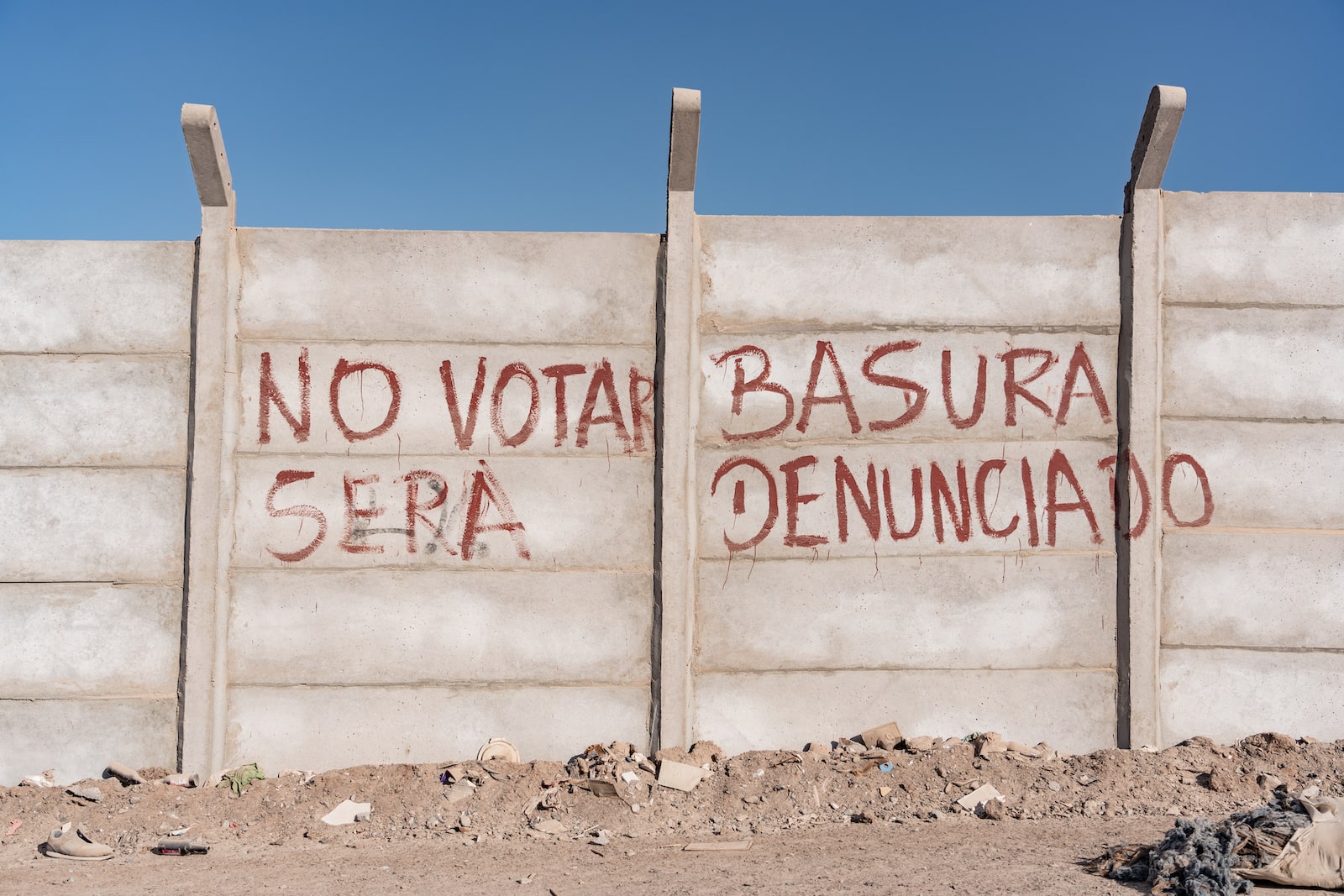
Although Paulin provided the court with Dress Desert’s smartphone video recordings of the clothes in flames, the defense argued that the Instagram account where they’d posted the videos could not be verified and confirmed. Lacking a certifiable timestamp, the films were inadmissible.
One year later, in August 2023, the Primer Tribunal Ambiental de Antofagasta called a trial hearing so that all parties involved in the case — the Consejo de Defensa del Estado, the body that judicially represents the state in Chile, the municipality of Alto Hospicio, and Silva — could present evidence.
During the hearing, the Mayor at Alto Hospicio, Patricio Ferreira, said that one of his priorities is to “transform this problem into an opportunity to generate employment.” He alluded to discussions he had with European businessmen to explore initiatives related to recycling.
Silva got people to testify in her favor, activists and academics who have given statements to different media outlets about the environmental problem generated by the textile landfill in the Chilean desert. But on the day of the hearing, none of them arrived.
“At the end of the day, in practice, I am alone in this action,” she said.
Chile’s government recently voted to adopt recycling measures that make certain producers accountable for their waste. Known as the extended producer responsibility law, or REP using its Spanish acronym, the legislation passed in 2016 and took effect in January 2023. Currently, Chilean companies that make tires and packaging (such as bags, plastics, paper or cardboard, cans and glass) must comply.
Eventually, according to the Ministry of the Environment, Chile intends to incorporate clothing and textiles as a priority product into the REP law.
However, in the case of clothes, many describe the REP as a “paper solution” that lacks tangible enforcement, said Pino, from the Universidad Diego Portales.
In parallel, the Ministry of the Environment is developing a circular economy strategy for textile waste. Unlike the REP, the agency crafts public policy for the public and private sectors to prevent overproduction.
The ministry has been holding workshops and conversations to collect input from stakeholders, including academics, business executives, retailers and nonprofit leaders. It is also tabulating the results of a preliminary survey on consumer clothes-buying habits. The details of this circular economy strategy is expected to be published in March this year.
At the minister’s invitation, Pino has shared her fashion expertise — both in the markets and in the desert — with the group. “These two things are wonderful initiatives,” she said about both efforts, but she lamented that they fail to address the issue of used clothes.

A decade ago, when the REP was first being discussed, Denisse Morán, president of the Tarapacá Recyclers and the head of ServiREC, a recycling cooperative that operates within Iquique’s free trade zone, sought out her local representative to request that the law apply to both clothing producers and clothing importers.
“Oh, because you are from Iquique?” she recalled him asking her.
“Not only because I am from Iquique,” she replied, “but because we all wear clothes.”
For years, many residents in Alto Hospicio saw the piles of textiles as more of an opportunity than an eyesore or environmental threat, something that supported the local economy.
When Jazmín Yañez arrived in town from southern Chile in 2018 almost penniless and on the brink of homelessness, for example, someone gave her a few cast-off garments and household garbage — from towels, kitchen implements to furniture — to sell. Ever since, Yañez, now 28, has waged a zealous campaign to salvage, fix, and reutilize all “waste” materials. She operates an informal store from the kitchen of her house called Stop Recicla: “Your trash is my treasure,” where she sells, exchanges, and gifts items such as rugs, used clothing, school supplies, costumes, and electronics to impoverished mothers, like she once was.
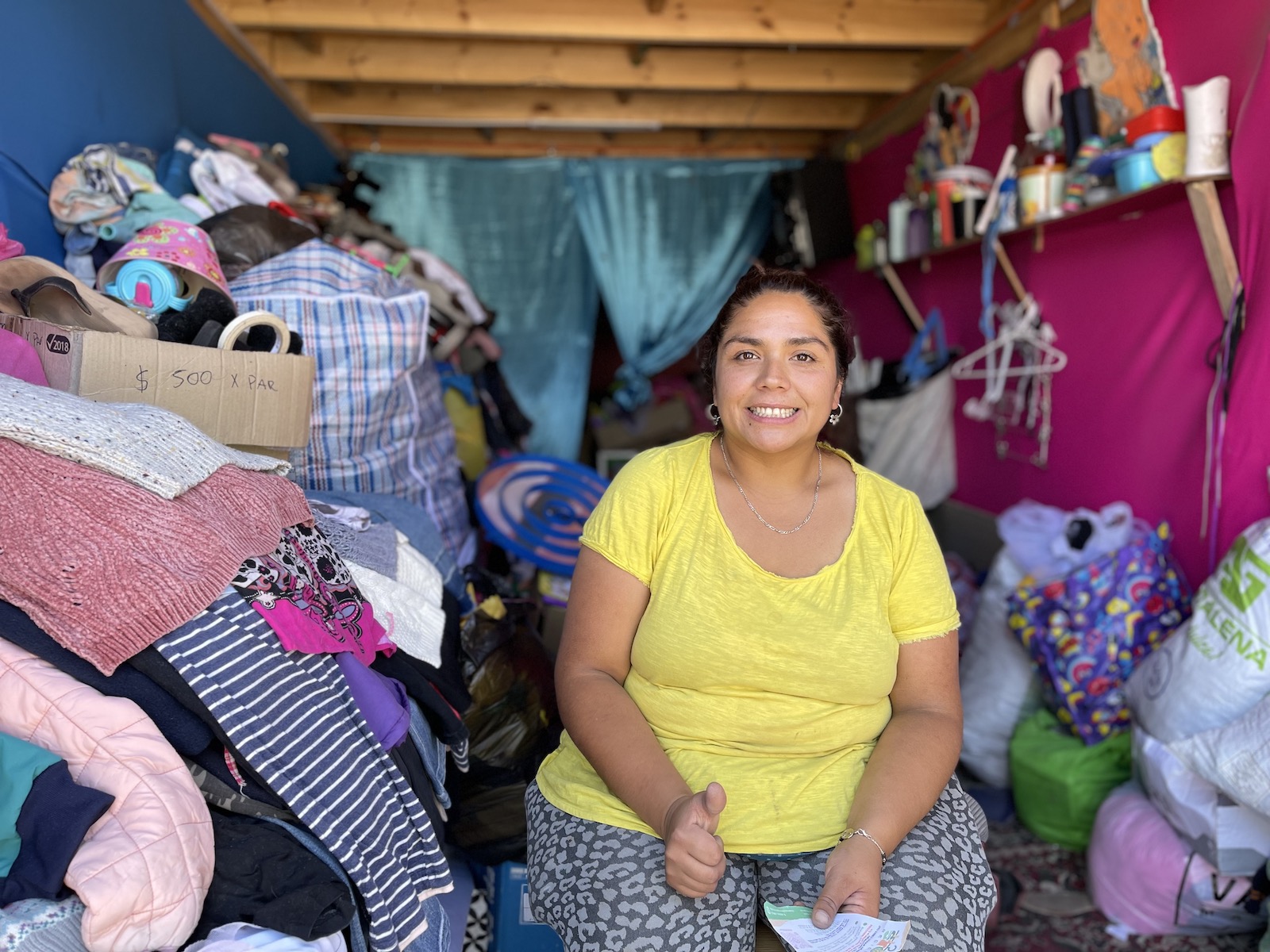
It’s this trash/treasure duality that kept Astudillo and other locals from viewing the region’s booming used clothing trade as a problem. But six months before the fires, in January 2022, Nathalia Tavolieri, a Brazilian journalist, invited Astudillo to El Paso de La Mula, where she encountered Manuela Medina’s mountain for the first time.
Astudillo had seen numerous clothing dumps strewn and mounded throughout the desert, but nothing as big as this immense tangle of blouses and pants. “It was terrible,” she said, weeping as she recalled her first visit. “Maybe if I had been older, maybe I could have done more things [to stop this from happening].”
The experience galvanized her. She had already co-founded her nonprofit Dress Desert, or Desierto Vestido, two years before, to raise awareness and creatively respond to the country’s burgeoning waste clothing issue. As part of the project’s efforts, she and 20 other members host workshops and conversations. They upcycle castaway materials into new garments and craft household items. Seeing the vastness of Medina’s clothing pile, Astudillo stepped up her resolve, because “many people don’t see — or don’t want to see.”
“It was very, very hard,” she said, “to know that we live in a place that is so polluted and damaged by everyone’s waste.” Several months later, Astudillo brought Gajardo, the clothes designer and a fellow Iquiquean, to the dump, and gained an ally in her efforts. Despite growing up and shopping at the region’s numerous outdoor secondhand clothes markets, Gajardo was appalled by the scope of the waste. She developed rashes from rummaging among the fabrics.
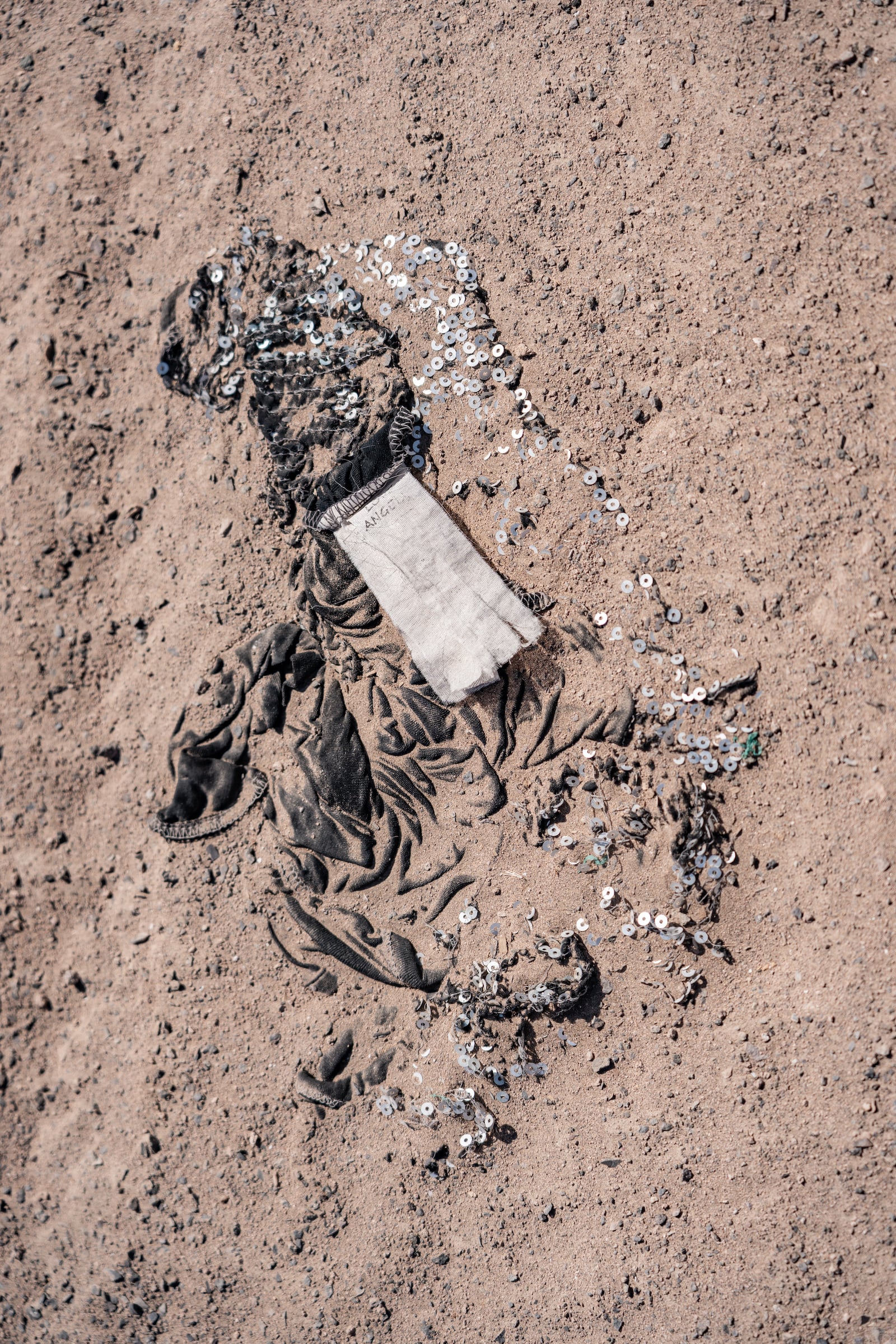
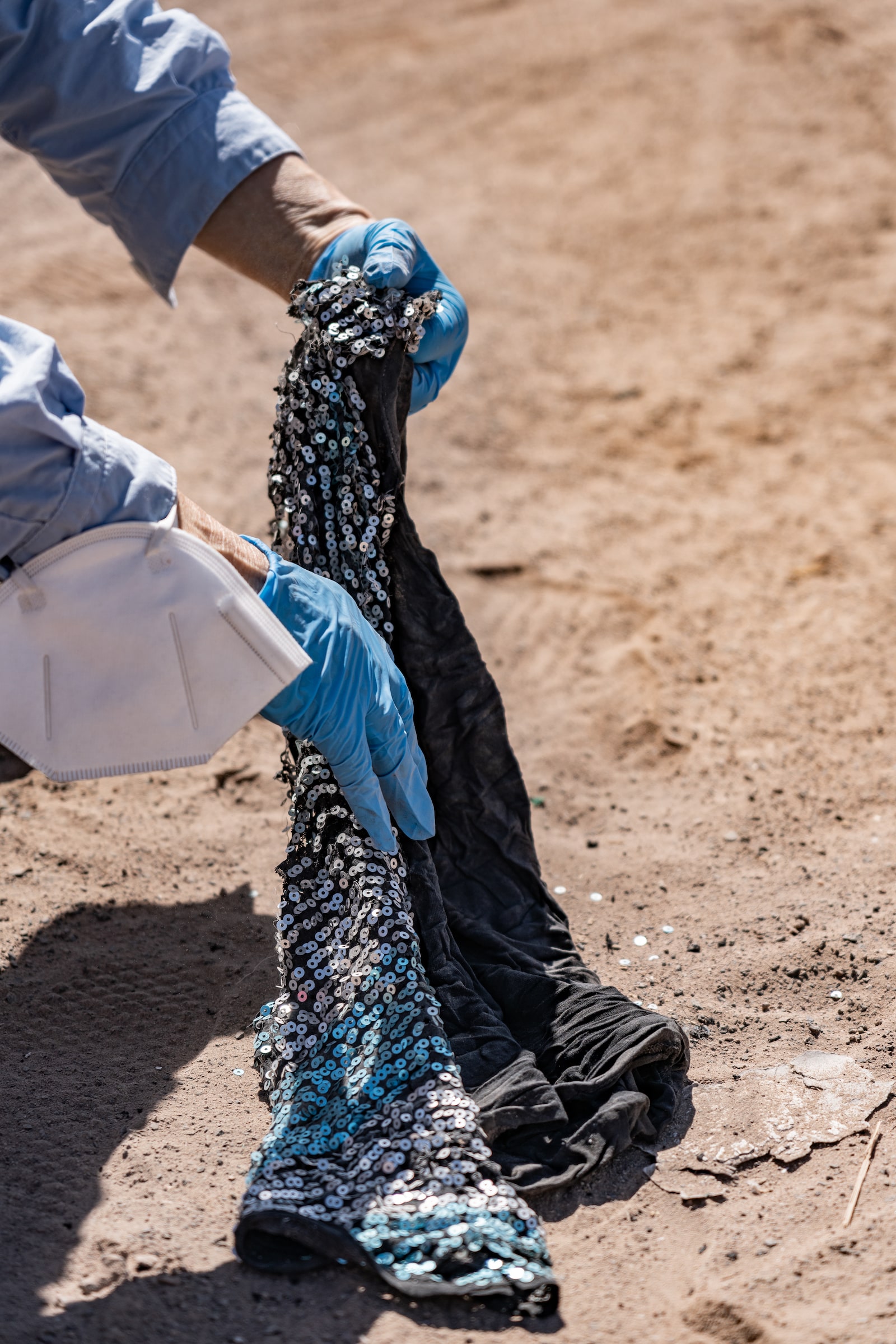

A garment emerges in stages from the desert sand in the Atacama Desert. Fernando Alarcón
“The fact that we have a desert, the fact that there’s a place to receive this, doesn’t mean that the place has to become the dump of the world,” she said. Since then, Gajardo’s conviction to never design clothes from virgin materials has deepened. Additionally, through her brand You Are the New Generation, she offers workshops in reusing garments, and visited Kansas City, Missouri, last year through the U.S. State Department’s Young Leaders of the Americas Initiative to teach people to make new clothes by harvesting old ones.
Other entrepreneurs have attempted to turn the clothes problem into revenue, but have faced a series of setbacks.
Franklin Zepeda is a celebrated Chilean entrepreneur who toured Europe’s textile recycling plants before returning to the region in 2013 to establish Ecofibre, now known as Procitex. (Its name is an acronym meaning Proceso Circular en Textil in Spanish).
With seed funding from CORFO, the Chilean economic development agency, and later from private capital, Zepeda was able to route textiles imported into Iquique to his plant, where they were disassembled, shredded, doused with flame retardant, and transformed into insulation panels. Zepeda got praise for this work in several major international news outlets, but he shuttered his plant in Alto Hospicio in 2021 because of unfavorable economics, including the taxes on shipping the insulation panels to other regions of the country.
Dario Blanco, manager of the ZOFRI User Association AG (AUZ), a trade association that brings together businessmen from the Iquique free zone, believes that the solution to the region’s problem of discarded clothing is out there — it will just take the right company and policies. And there are plenty of entrepreneurs, fashion designers, and environmentalists working on the issue of textile waste, both in Chile and internationally.

As Bloomberg reported in May, New York, California, Sweden, and the Netherlands are developing legislation similar to Chile’s extended producer responsibility law that went into effect this year, mandating that the fashion industry fund recycling programs via tariffs calibrated to the quantity of garments produced.
In order to help New York City uphold its existing law limiting or forbidding textiles in the waste stream, FabScrap, a nonprofit founded in 2016 by a former New York Department of Sanitation worker, receives 7,000 pounds of pre-consumer textile waste each week. Sorted by volunteers, the nonsynthetic scrap items are sent to a New Jersey facility that shreds the material, producing “shoddy,” a stuffing used to fill punching bags, sofas, and soft toys.
A Czech company called RETEX has been attempting to bring its fabric-macerating technology to Alto Hospicio. Blanco says that in exchange for securing a contract with Chile, the company promised to hire local workers. But, Blanco admitted, negotiations like these have fallen through in the past. For example, he said, a Spain-based company, Egreen, planned to open a fabric-waste processing plant, but the deal was scrapped late last year.
The governor’s sustainability adviser at the Regional Government of Tarapaca, Pablo Zambra, recently formed a 25-member committee that includes stakeholders such as Astudillo and Barria from Dress Desert and Morán, the president of the Tarapacá Recyclers, to publicize economic incentives for circular economy initiatives. Collectively, they hope RETEX will succeed in doing what Zepeda’s company failed to do: turn a profit. As of this writing, no importers are involved.
Meanwhile, every day, container ships continue to offload more cargo.
In the fall of 2022, Alto Hospicio’s mayor, Ferreira, acknowledged the unsolved problem but blamed clothing manufacturers, citing a “lack of global awareness of ethical responsibility.”
“Our land has been sacrificed,” he said.
Pino agrees that the fashion industry and its consumers are culpable. “We have to worry about the complete cycle: before, during, and after our clothes,” she wrote in an editorial published in 2021.
She believes a more comprehensive solution is necessary, including regulating the entry of textile materials to Chile, educating consumers about prolonging garments’ lives, promoting Chile’s homegrown fashion industry, and supporting research to design new uses for fabric waste.
Ecocitex, founded in 2020 by engineer Rosario Hevia in Santiago, has sprung up as another Chilean company addressing a surfeit of garments.
Ecocitex operates in a manner contrary to the country’s organized and informal secondhand clothes markets. It invites people to recycle high-quality clothing or pay $1.50 per kilogram to leave poor quality clothing and walk away empty-handed.

During the pandemic, Andrea Espinoza Pérez, a civil industrial engineer at the University of Santiago, initiated a study on the ecological impacts of projects like Ecocitex. She wanted to know: Did factory-processed, used clothing produce fewer emissions than the original clothing manufacturing process? With data provided by Ecocitex’s founder Hevia, scientists determined that the clothes deconstruction process is effective because it keeps waste clothes out of landfills, and it replaces the demand for virgin materials. However, the study found that Ecocitex’s procedure is highly energy-intensive — using about 73 percent of the energy required to produce the same product from raw materials.
Meanwhile, neither Zepeda’s Procitex nor Hevia’s Ecocitex in Chile, nor Fabscrap’s efforts in New York and Philadelphia, have matched the direct profitability of Medina’s now-defunct business. (Medina has started a new business storing tires.) In fact, all have relied heavily on a variety of underwriting measures, including subsidies, nonprofit funding, subscriptions, or volunteer labor to generate their products.
In recent years, Zepeda has earned his living as an employee of Chile’s largest retailer, CENCOSUD. He collects surplus clothes donated by customers, and produces insulation panels for buildings that are sold by the same retailer.
As for Ecocitex, in June, the business caught fire and the building was destroyed. The cause is still under investigation. Undeterred, Hevia has launched a campaign to rebuild. Meanwhile, she is raising funds by selling blankets made from recycled fibers to a mining company.
By last January, the height of the Chilean summer, the gigantic, unsightly clothes dump at El Paso de la Mula, the one Agence France Presse had shown the world, was nowhere to be found.
All that remained was a smattering of ashes and the tread marks of bulldozers. Here and there, across Medina’s unofficial backyard, small piles of garments peeked out of the sand dunes. But according to municipal officials, dumping and burning continues. Rey, an indigent man who lives by the side of a desert road in a blue and yellow tent emblazoned with “National Geographic,” attests that he and others accept money from nonprofit refuse-disposal contractors or freelance truckers in exchange for setting fires to whatever waste is discharged from a truck. This way, the trucker can keep more of his hauling profits, which would otherwise be whittled down by the official dump fees.
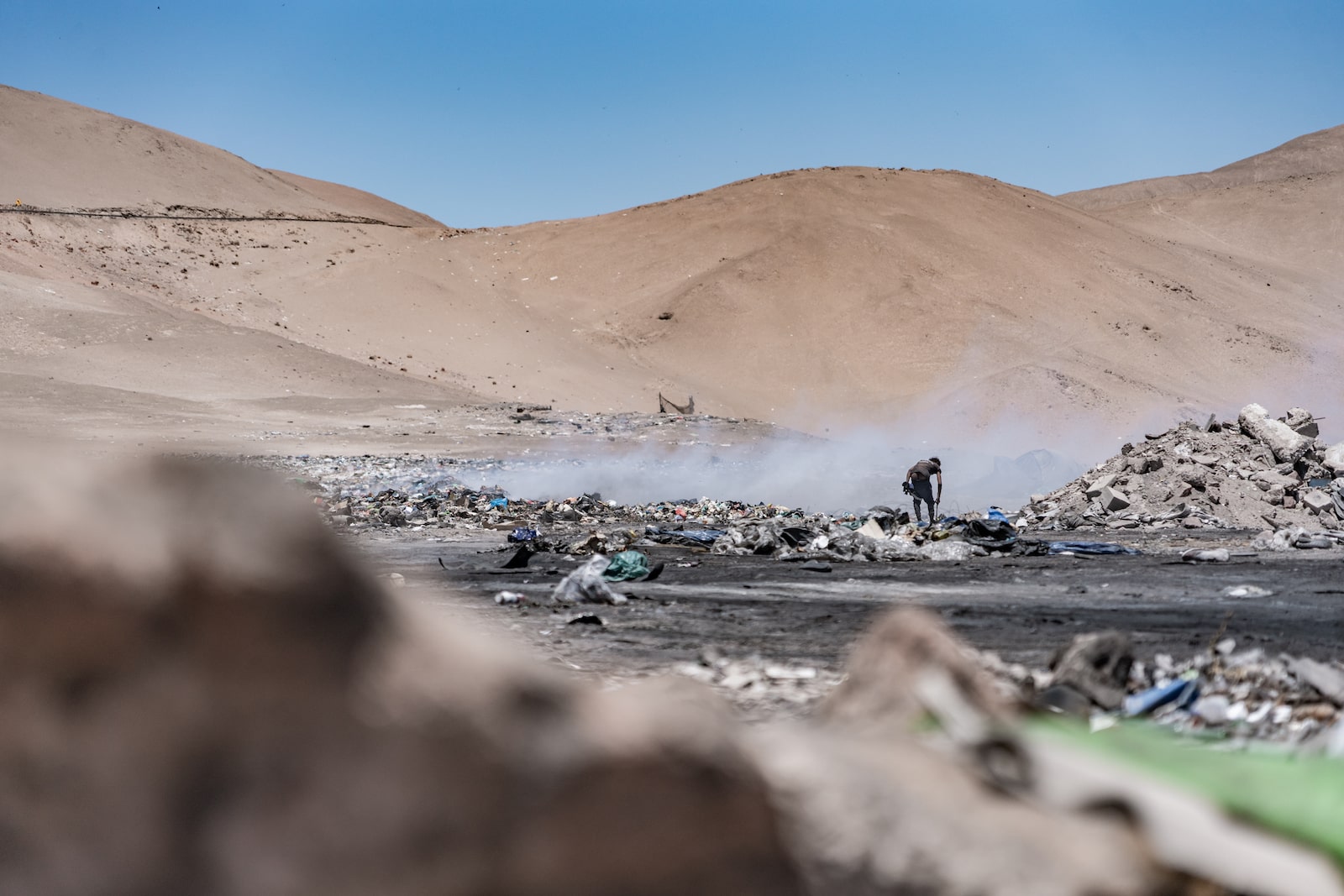
Astudillo says that beyond the limits of Manuela’s dune, there are as many as 200 micro-garbage dumps, and consequently, miles and miles of ashes in the desert — not just scattered over the ground, but also in the air. She told Grist in late December that this is an everyday thing. “You go out to buy bread and you smell the burning smell. You smell the materials that make up the clothes: oil and plastic. After 5 in the afternoon, I no longer let my 7-year-old daughter leave the apartment, and I close the windows to prevent smoke from coming in.” She also confirmed the abandoning of clothes continues: “They throw it away, they burn it immediately.”
On December 12, the Primer Tribunal Ambiental de Antofagasta issued its final ruling in the case with Silva, commissioning a unit of experts to carry out an on-site report on the accumulation of textile waste in different areas of Alto Hospicio, and to propose a solution to the accumulation of waste.
The municipality of Alto Hospicio, which claims it does not have the workforce to adequately address the problem, has also installed nearly 100 cameras along the main roads as a means of tracking polluters, and has begun doling out fines as high as $350 for illegal dumping. So far, trucks have been apprehended transporting domestic and industrial garbage, as well as bulky items such as mattresses, washing machines, and furniture.
Drone footage recorded by Cheng Hwa, one of Pino’s students, the day of the June 2022 fires captures the municipality fighting what was in essence an oil fire. Hwa, who grew up in Iquique and now works in tech for the hospitality industry, had long been aware of the desert dumps but didn’t comprehend the magnitude until he witnessed them at close range.
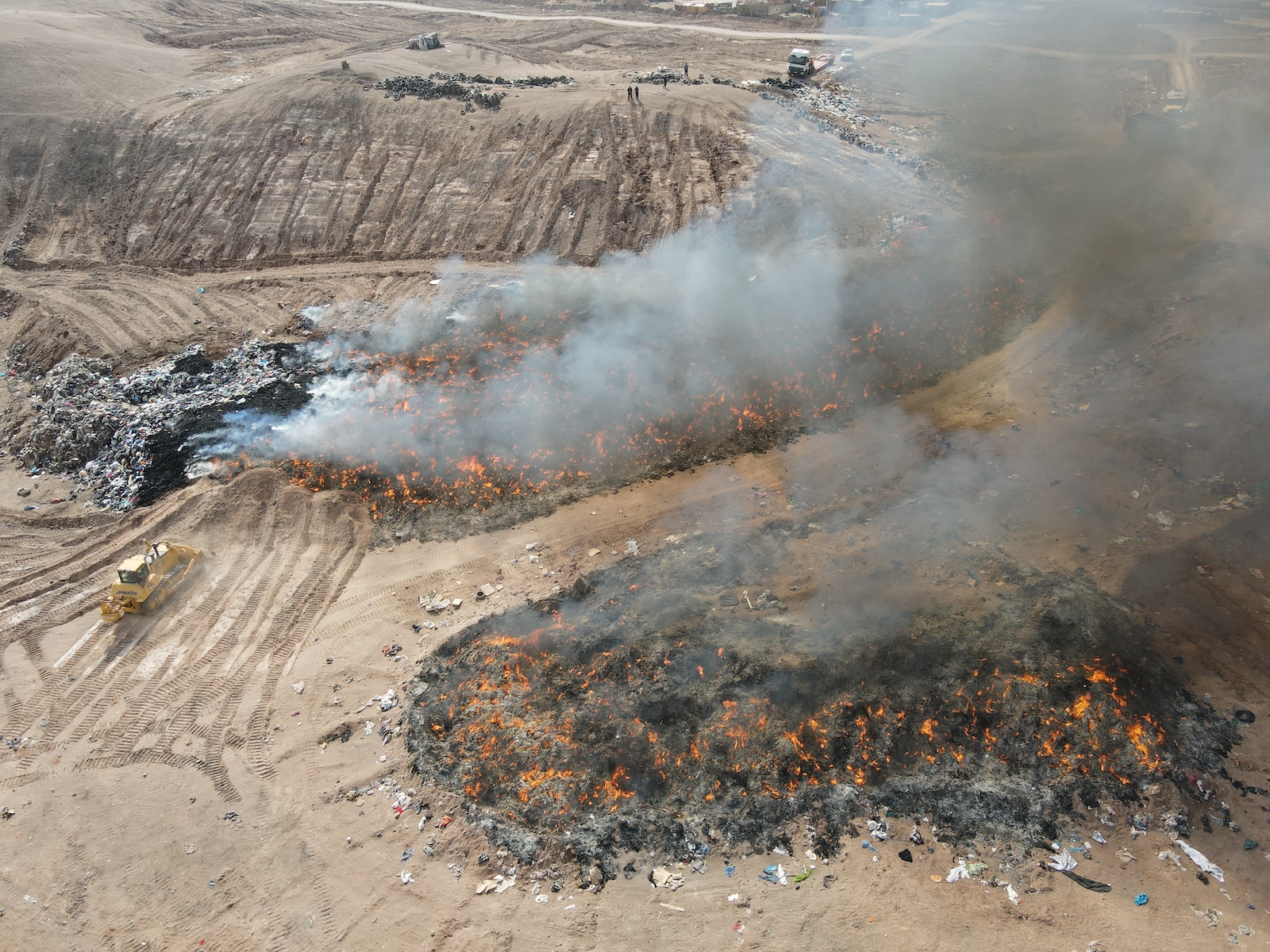
He’s haunted by what his drone footage made visible. “How the desert of sand starts to turn into a desert of clothes,” he said. “It has no limit; there is no closure … Clothes begin to appear on the ground until the horizon is completely covered.”
In Iquique, he often glances up toward the high plateau of Alto Hospicio. “You can’t see the dump, but [you can see] the column of smoke on days that [clothes] burn. That cloud of smoke lets you know … It makes [the issue] visible on a day-to-day basis.”
Thirty miles south of Iquique, toward the city’s main airport, on her family’s farm, Astudillo and her parents drop pieces of used clothing on the ground, but in a purposeful way. Over the past 20 years, Astudillo’s father has experimented with growing trees in the infertile, saline soils. Many of his efforts failed until he began using certain fabrics to mulch his trees. This improves the quality of the soil, enabling it to retain moisture. For the past year, Astudillo has been working with one of the Zofri importers, who asked to remain anonymous. She consults with his staff about the clothing bales and recommends ways of sorting the material into specific categories based on fiber content, some of which she collects personally. Those items — a pair of cotton shorts, a T-shirt, a blouse — become mulch for a pine and eucalyptus forest rising in the desert.
Recently, as Astudillo was leaving the farm, she stashed a few perennials in her truck and drove them to Manuela’s compound in Paso de La Mula. Just beyond Medina’s courtyard, where sky- blackening fires had once burned, Astudillo troweled a small hole for the plants. As she dug, she dislodged several odd socks and a faded blue sweatshirt — discarded clothes that had survived the fires, but were buried by bulldozers.
Astudillo filled the hole, amending the desert sand with compost and garden soil. “For me it’s like a Band-Aid for a wound that is so big in that place,” she said. Then she tucked in cardinal flowers — a native plant whose petals resemble shooting flames.
Editor’s note: During visits to her compound in Alto Hospicio, Manuela, the owner of the secondhand clothing dump, told Grist reporters her name was Manuela Medina. However, other outlets have used the surname Olivos. Her legal name is Manuela de Los Angeles Medina Olivos.
This story was originally published by Grist with the headline A mountain of used clothes appeared in Chile’s desert. Then it went up in flames. on Jan 4, 2024.
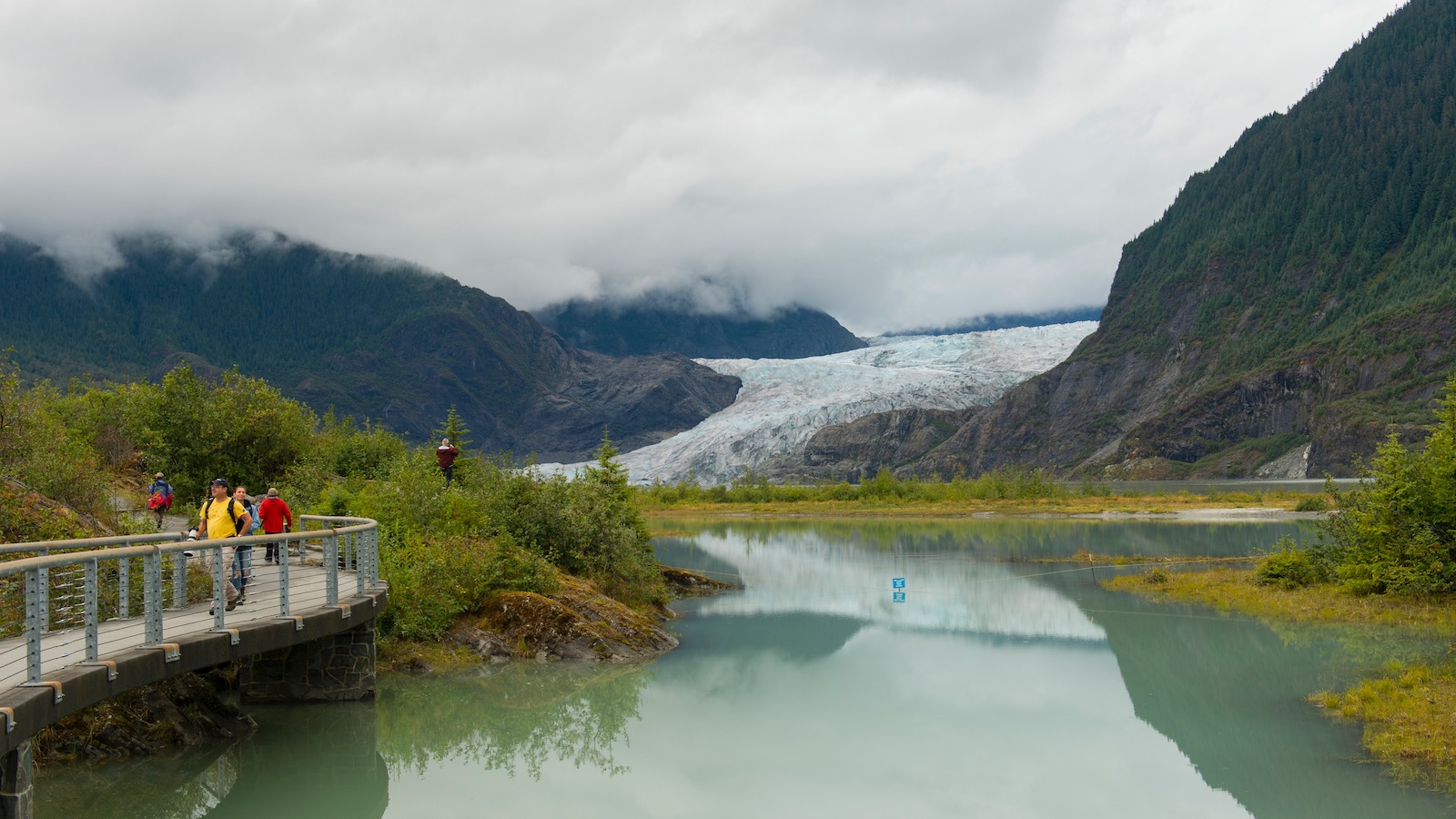
When Kira Roberts moved to Juneau, Alaska, last summer, she immediately noticed how the town of 31,000 changes when the cruise ships dock each morning. Thousands of people pour in, only to vanish by evening. As the season winds down in fall, the parade of buses driving through her neighborhood slows, and the trails near her home and the vast Mendenhall Glacier no longer teem with tourists.
“That unique rhythm of Juneau is really striking to me,” she said. “It’s just kind of crazy to think that this is all a mile from my house.”
But Mendenhall is shrinking quickly: The 13-mile-long glacier has retreated about a mile in the past 40 years. Getting all those tourists to Juneau — some 1.5 million this summer by cruise ship alone — requires burning the very thing contributing to its retreat: fossil fuels.
In an effort to mitigate a portion of that CO2, some of those going whale watching or visiting the glacier are asked to pay a few dollars to counter their emissions. The money goes to the Alaska Carbon Reduction Fund, but instead of buying credits from some distant (and questionable) offset project, the nonprofit spends that cash installing heat pumps, targeting residents like Roberts who rely upon oil heating systems.
Heat pumps are “a no-brainer” in Juneau’s mild (for Alaska) winters, said Andy Romanoff, who administers the fund. Juneau’s grid relies on emissions-free hydropower, so electricity is cheaper and less polluting than oil heat. They also save residents money — Roberts said she was paying around $500 a month on heating oil, and has seen her electricity bill climb just $30.
“The financial difference is huge,” she said
Programs from Monterey, California, to Lancaster, Pennsylvania, have tried using similar models to finance local renewable or energy-efficiency projects, and carbon offsets for flying and other activities are nothing new. But most of the voluntary market for such things is run by large companies backing distant projects. The fund in Juneau is eager to capitalize on the massive tourist interest in its backyard.
The program, which until recently was called the Juneau Carbon Offset Fund, started in 2019 when members of the advocacy organization Renewable Juneau were discussing how to help Juneau achieve its goal of having renewables provide 80 percent of the city’s energy needs by 2045. The organization’s existing heat pump programs were reaching only the “low-hanging fruit,” Romanoff said: People who had money and were ready to switch for climate reasons alone. It envisioned the fund as a way to get the devices — and the fossil fuel reduction they provide — to more residents.

Romanoff, who also is executive director of the nonprofit Alaska Heat Smart, is aware of the reputational hit carbon offsets have taken lately, but believes the fund’s focus on heat pumps, and working locally, provides transparency and accountability. “It’s a carbon cost that people could actually relate to and understand,” he said.
Many voluntary offset projects overestimate the emissions they’re preventing, sometimes by as much as five to 10 times, said Dr. Barbara Haya, director of the Berkeley Carbon Trading Project. “Project developers are making methodological choices that give them more credits instead of less,” she said, and those verifying the claims are not enforcing conservative estimates when there’s uncertainty.
The Alaska Carbon Reduction Fund uses three years of utility bills to determine how much oil a recipient was burning before getting a heat pump. It’s paid for 41 installations since 2019, at an average cost of $7,000, and estimates the devices will prevent 3,125 metric tons of carbon emissions over their 15-year lifespan. Those calculations, plus a subsidy from non-tourism donations, brings its carbon price to $46 a ton.
That’s more expensive than many voluntary credits, but in line with what Haya said are higher-quality projects. “That looks like the cost of real mitigation,” she said. A more fundamental issue is proving any offset project wouldn’t have happened on its own, Haya said.
Romanoff believes their project meets that condition because the heat pumps go to residents who earn less than 80 percent of the local median income. One of the first recipients, Garri Constantine, lived on far below that when his system was installed. In the three years since, Constantine has become an evangelist for the technology, in part because he no longer spends $300 a month on firewood, trading it for a $50 monthly increase in his electricity bill.
“I just don’t understand why these things haven’t taken off like wildfire,” he said.
Although the fund has money for future installations, Romanoff said the speed with which it can work is limited by a nationwide shortage of installers. Most of its donations came from the nearby gold mine, but Allen Marine, a regional tour operator, started pitching the fund to passengers this summer and offers an opt-in donation when booking online. It considered the fund an opportunity to “give back to the communities that we operate in,” said Travis Mingo, VP of operations. As part of the partnership, the carbon reduction fund agreed to start funding heat pumps in other Allen Marine destinations, like Ketchikan and Sitka.
A much smaller company, Wild Coast Excursions, includes the offset in its prices. When owner Peter Nave’s plan for summer tours on the local ski mountain fell through, he shifted to bear viewing and alpine hiking trips, some of which are far enough away to require helicopter rides. Climate change is especially visible for Nave, a Juneau native who’s seen the dramatic changes in Mendenhall up close and has worked as an avalanche forecaster. He’s covering a 125 percent offset of the climate impact of those excursions, labeling his company “carbon-negative.” He estimates that will end up being about 1 percent of the price of each tour. In his mind, it’s simply a cost of doing business.
“I kind of rationalized that if I could offset more than we would use, then I could feel a little bit better about taking on [the helicopter] strategy,” he said.
He’s skeptical of offsets in general, but the tangibility of this program made a difference. “I could see the reduction happening, because I know the heat pumps work, my friends have them, people I know install them,” he said.
Wild Coast Excursions’ contribution to the carbon reduction fund in the first year is unlikely to cover even one heat pump, however. Including cruise ships or major airlines in the program would make a far more significant dent in Juneau’s emissions. Romanoff said his organization had an initial conversation with a local representative of a major cruise company, but was told it wouldn’t participate if the fund only benefits Juneau and the offsets weren’t verified by a third party.
The Alaska Carbon Reduction Fund began pursuing verification with Verra, the world’s largest certifier of voluntary credits by volume, but walked away because of the cost and its own discomfort over negative press coverage. “We could install five or six heat pumps with that money,” Romanoff said.
Offsets are one tool cruise companies consider “on a case-by-case basis,” to hit their own emissions goals, said Lanie Downs, a spokeswoman for Cruise Lines International Association Alaska.
Carnival Plc, which owns three cruise companies operating in Alaska, said it will consider carbon offsets only if energy efficiency options have been exhausted. The other two major cruise lines that regularly dock in Juneau did not respond to requests for comment, but do list offset purchases in their annual sustainability reports.
While the city charges cruise lines a per-head passenger fee, that revenue can be used only for specific projects in the port area. Alexandra Pierce, Juneau’s tourism manager, said the city has “never formally proposed any emissions fees,” on cruise ships, but pointed to the industry’s involvement in efforts to reduce cruise line emissions and install electric shore power, the marine equivalent of stopping idling emissions.
Allen Marine has “started discussions” about including an offset fee in its tours sold through cruise lines. “As we go through contract renewals, it will actually start to snowball effect the amount of money we’re able to receive for this program,” Mingo said. But ultimately, that leaves the bulk of tourists’ emissions — the cruises — unaccounted for.
Romanoff gets a few emails a year from people in other parts of Alaska and the Lower 48 interested in setting up their own offset fund. He thinks his organization’s model could be replicated in places with plenty of oil heating systems to replace. That said, a carbon price based on replacing gas-powered heat might be too expensive for most people, he said.
But in the Alaskan panhandle, he thinks a “groundswell” of support from small businesses could make a difference in getting the cruise lines on board. “Once we build that arsenal to a certain size, then I think that’ll speak pretty loud and clear,” he said.
This story has been updated.
This story was originally published by Grist with the headline In Juneau, Alaska, a carbon offset project that’s actually working on Jan 4, 2024.